Professional best practice from the Institution of Lighting Professionals June 2023
REST, STOP
Drinking in the views (and the lighting) at the Espenes Rest Stop in Norway
‘IT NEEDS TO BE DEEDS NOT WORDS’
Unpicking what lighting needs to do to become more racially and ethnically diverse
‘WE CAN BE A STRONG, INDEPENDENT INDUSTRY’
Michael Grubb on why he’s never been more excited about the future of lighting design
The publication for all lighting professionals

Modular (2X2) refractive lenses in PMMA with 5 optical distributions available. Shield in flat tempered glass with impact resistance IK10 and prismatic IK07. Upper



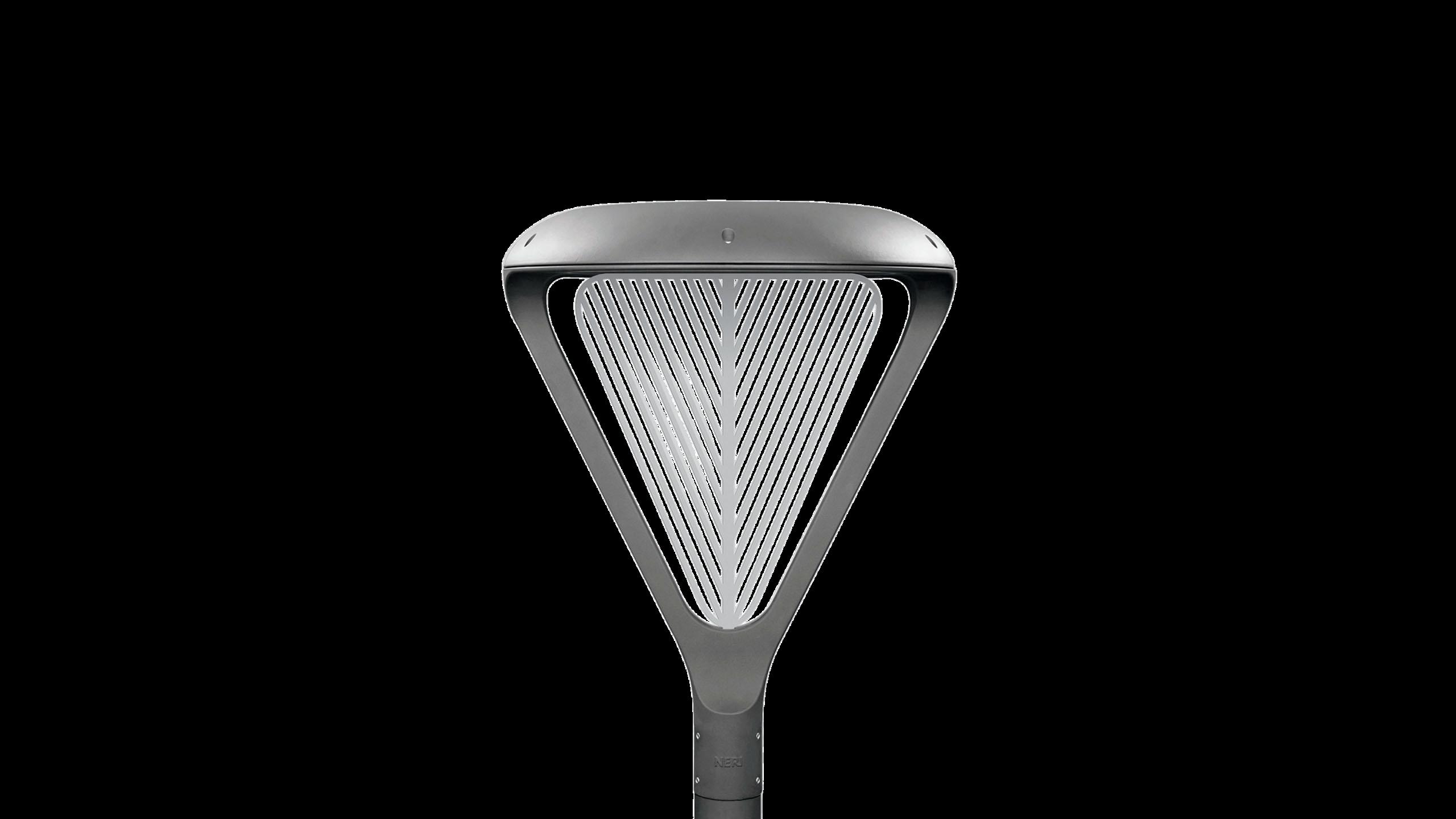
Discover More asdstreetlighting.com +44 (0) 1709 374898 sales@asdlighting.com Optical package consists of 8 geometries. Enclosure protection: IP66, IK08. Transparent or prismatic glass screen. Luminous flux from 350lm to 4,500lm per light source.
Lumen output between 1,500 and 15,000. Can be ordered with or without the blade. The blade is a customisable aluminium screen that separates the brackets, filters light and can be laser-cut to specific designs or colour tinted.
frame shaped bell in aluminium with threaded connection G 3/4″.
REST, STOP
The facilities at Espenes Rest Stop in Hardanger, on the west coast of Norway, may be somewhat basic. But that is more than made up by its stunning views and pristine darkness, all enhanced by a highly pared back lighting scheme that has been achieved solely from the ground upwards
‘IT NEEDS TO BE DEEDS NOT WORDS’
Does lighting have a race and ethnicity inclusion problem? Lighting Journal brought together a panel of lighting designers and engineers to grapple with what is a complex and challenging question, and consider how lighting can reach – and attract – a wider, more diverse population
‘WE CAN BE A STRONG, INDEPENDENT INDUSTRY’

When we talk of the future of lighting design we often focus on changes in technology or science. But, as Michael Grubb argues, lighting design is also changing fast in how it works, who it works for and collaborates with and, just as importantly, who works for it


PUMP UP THE VOLUME
The lighting scheme for the new FitnGlam gym in the Dubai Hills Mall brings colour, high contrast and fun to this women’s-only workout space. In the process, explains Eline Maftoum, it creates a sense of transition through its different zones and an emotional connection to each space

SPOTLIGHT ON HEALTH
Following the ILP and SLL’s evidence to the Lords Science and Technology Committee’s inquiry into light and noise pollution, three more leading figures from within the industry fed in important perspectives during April
‘THE STARS HAVE LOST ONE OF THEIR GREATEST FRIENDS’

Bob Mizon, one of the industry’s bestloved and most effective campaigners against light pollution, sadly passed away in April. Steve Tonkin reflects on his contribution to dark skies


‘OPEN’ TO INNOVATION
The use of open-neutral fault detection technology could accelerate electric vehicle charging infrastructure, providing social, economic and environmental benefits, argues
James Barker
FAMILY FORTUNES
As well as enjoying CPD and networking, let’s use this this month’s Professional Lighting Summit to celebrate the longstanding relationship between the ILP and its lighting manufacturer ‘family’, writes Matt
Murray
LET’S GET TALKING
The ILP’s ‘Strategy 2026’ fiveyear roadmap will be a key talking point at the Professional Lighting Summit later this month. ILP Chief Executive Justin Blades outlines how members can help
MANCHESTER MATTERS
With the speaker line-up confirmed and delegate booking now open, don’t delay in signing up for what promises to be a Professional Lighting Summit to remember from 14-15 June. Jess Gallacher outlines what you can expect
GOODBYE JESS!
After 22 years at the forefront of shaping – and often leading – lighting’s conversations, the ILP’s Knowledge Transfer and Communications Manager Jess Gallacher is moving on to pastures new. As our industry testimonials show, she will be sorely missed
‘THERE’S ALWAYS A WAY TO IMPROVE LIGHTING TO BENEFIT THE USERS OF A SPACE’








With the Young Lighting Professionals chair set to hand over later this month, current YLP chair Toby Penter outlines how he came into the industry and what inspires him about lighting
COVER PICTURE
The Espenes Rest Stop in Hardanger, Norway, showing the award-winning lighting scheme by Light Bureau. Turn to page six, where Arve Olsen explains the thinking behind the scheme and the challenges of getting from concept to realisation. Photograph by fovea.studio

Contents 26 12 40 48 20 www.theilp.org.uk JUNE 2023 LIGHTING JOURNAL 3 OUR EMINERE™ LINE UP EMINERE™ anolislighting.com 06 42 48 50 52 56 58 12 20 26 34 40





500-4,500lm AIR2 2,000-22,000lm AIR3 20,000-58,000lm AIR RANGE PoweredbyDirectDriveandrangingfrom3.1kg to11.2kg,theAIRrangeisperfectforthemost challengingtrafficapplications. www.indolighting.com w +44(0)2030511687 info@indolighting.com
Volume 88 No 6
June 2023
President
Fiona Horgan
Chief Executive
Justin Blades
Editor
Nic Paton BA (Hons) MA
Email: nic.cormorantmedia@outlook.com
LightingJournal’scontentischosenand evaluatedbyvolunteersonourreaderpanel, peerreviewgroupandasmallrepresentative groupwhichholdsfocusmeetingsresponsible forthestrategicdirectionofthepublication. Ifyouwouldliketovolunteertobeinvolved, pleasecontacttheeditor.Wealsowelcome reader letters to the editor.

Graphic & Layout Design
George Eason
Email: george@matrixprint.com
Advertising Manager
Emma Barrett
Email: ebarrett@matrixprint.com
Published by
Matrix Print Consultants Ltd on behalf of Institution of Lighting Professionals

Regent House, Regent Place, Rugby CV21 2PN
Telephone: 01788 576492
E-mail: info@theilp.org.uk
Website: www.theilp.org.uk
Produced by
Matrix Print Consultants Ltd
Unit C, Northfield Point, Cunliffe Drive, Kettering, Northants NN16 9QJ
Tel: 01536 527297
Email: gary@matrixprint.com
Website: www.matrixprint.com
© ILP 2023
The views or statements expressed in these pages do not necessarily accord with those of The Institution of Lighting Professionals or the Lighting Journal’s editor. Photocopying of Lighting Journal items for private use is permitted, but not for commercial purposes or economic gain. Reprints of material published in these pages is available for a fee, on application to the editor.
In truth, it was always unlikely that our panel discussion in April on race and inclusion within lighting was going to come up with any magical solutions to solve racial and ethnic discrimination and prejudice, whether within lighting or elsewhere.
For me, however, the very fact we had the conversation at all, as we report from page 12, was valuable. What it brought home to me was that, while lighting clearly does still very much have issues it needs to address around becoming less White, male and aged – especially at senior levels – much of the day-to-day prejudice and often casual racism revealed by our panel was as much societal or structural as specific to lighting per se.
The ‘but where are you really from?’ questioning, assumptions around ‘non-ethnic’ names, the double-takes as you walk into meetings, the seas of White faces at events, all these, it is clear, can and do still happen within lighting. But they are, sadly, also a wider reflection of our inequitable and often still prejudiced and biased society as a whole (consciously or unconsciously).
Equally, one theme that came through very clearly in our discussion is the impact of (again often systemic) socio-economic barriers. The fact lighting is both a technical science and a creative art can act as something of a double barrier to entry, especially for those from more disadvantaged backgrounds.
Compounding this is the fact that, often, there will still be a degree or even postgraduate degree entry requirement, especially within lighting design. And this is before we even get to the fact that lighting as a career just isn’t that visible as an option in schools, colleges or even universities.
This is one reason why, to my mind, it is so important that ‘pathways to entry’ is a key part of the ILP’s ‘Strategy 2026’, as chief executive Justin Blades outlines from page 50. As he writes, getting the strategy from aspiration to reality is complex and will take time. It is also, absolutely rightly, something members need to be involved in, and engaging with, at every stage.
As we all look forward to the Professional Lighting Summit later this month (and do see our final preview from page 52), these are exactly the sort of lively conversations I’m looking forward to having with members in Manchester.
Like with our panel discussion, I don’t expect we’ll arrive at hard-and-fast answers, let alone silver-bullet solutions. But, as the advert says, it’s good to talk.
Nic Paton Editor

The ILP wishes congratulations to King Charles III and Queen Camilla on the event of their coronation in May.

Best wishes and good luck from the President, Board of Trustees, staff, and members of the ILP.
SUBSCRIPTIONS
ILP members receive Lighting Journal every month as part of their membership. You can join the ILP online, through www.theilp.org.uk. Alternatively, to subscribe or order copies please email Diane Sterne at diane@theilp.org.uk. The ILP also provides a Lighting Journal subscription service to many libraries, universities, research establishments, non-governmental organisations, and local and national governments.

Editor’s letter
JUNE 2023 LIGHTING JOURNAL 5
anolislighting.com
HIS MAJESTY, KING CHARLES III AND QUEEN CAMILLA
THE ARCHITECTURE OF LIGHT
REST, STOP
The facilities at Espenes Rest Stop in Hardanger, on the west coast of Norway, may be somewhat basic. But that is more than made up by its stunning views and pristine darkness, all enhanced by a highly pared back lighting scheme that has been achieved solely from the ground upwards
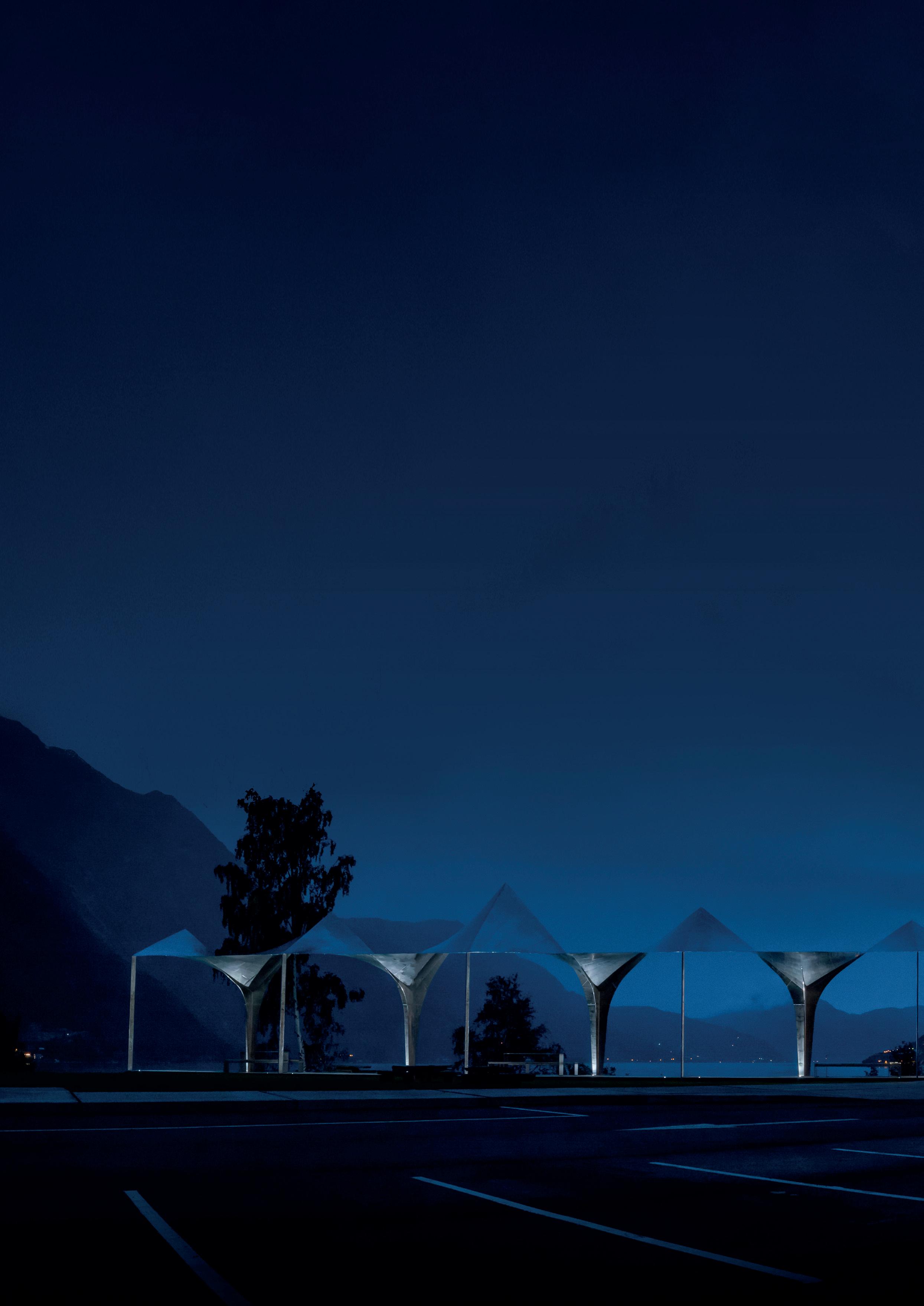 By Nic Paton
By Nic Paton
Leicester Forest East, Newport Pagnell, Watford Gap, Hartshead Moor –behold and gently weep.
Granted, the Espenes Rest Stop in Hardanger, western Norway, is not somewhere you’re going to be able to pick up an M&S meal deal or a quick Costa. It is, basically, just a rest stop with toilet facilities. But the breath-taking views out across Hardangerfjord (the second longest fjord in Norway) are more than enough to drink in.
And that’s even before we get to the added treat for lighting professionals: the award-winning lighting scheme created by Light Bureau for this architecturally stunning site.
As Arve Olsen, design director for Light Bureau UK, tells LightingJournal: ‘The idea was really just to bring the inspiration of the site, the nature that surrounds the space, to the architecture; the cool moonlight that illuminates the surrounding mountains in contrast to the warm light that belongs to us humans.’
The Espenes Rest Stop is part of an initiative called Norwegian Scenic Routes, run by the Norwegian Public Roads Administration, to create a network of cultural sites and stopping points
that have nature as their backdrop, in the process uniting architects, artists, designers and craftspeople.
PRISTINE DARKNESS
It is located on Highway 13, which winds along the fjord, and originally was little more than simply a layby on the side of the road, with a very basic set of toilets. The highway itself is not illuminated to preserve the pristine darkness of the environment.
‘The thing with this project is that, as part of these tourist roads and scenic routes, it is all about the interplay between the landscape and surroundings. To create a space that either works with the surroundings or is intentionally contrasting against it,’ says Arve.
The project began in November 2018, with the entire construction built in stainless steel and designed by Code Arkitektur. The roof and wall surfaces were shaped by hand and welded together from 6mm-thick steel plates. However, as Arve makes clear, this choice of quite thin steel plating created its own headache from a lighting perspective.
‘Initially, the intention was for all of the internal walls to be made from polycarbonate, which we could have integrated the lighting into,’ he says. ‘But the architects were really struggling with it because they felt that having mullions between the frames of the materials just gave everything away. You lost a bit of the magic.
‘They therefore started to move away from that and towards a concept where everything was made out of stainless steel instead. The intent was for it all to be able to be read as one big sculpture rather than as a kit of parts that had been put together.
‘For us, however, there were some
JUNE 2023 LIGHTING JOURNAL 6
The Espenes Rest Stop in Norway. All images by fovea.studio
challenges to that. Because the whole-steel structure only used 6mm-thick plates, there was no way for us to get any kind of power into the structure, no way to channel, cable or integrate the lighting into it. There were no double walls of metal or anything like that. So, everything from our side had to come from the ground upwards, from the concrete slab foundations,’ he explains.
The lighting of the 50m-long ceiling surface is asymmetrical and means you experience it differently depending on which direction you are observing the building from.
As Arve explains: ‘When you’re standing looking outwards towards the water, we didn’t want to
Architectural lighting
surface. We also located lighting within the door blades. The toilets, in fact, were challenging. Because we couldn’t recess any kind of motion detectors into the bathrooms, there was no sensible way for us to do presence detection.
‘In the end we ended up with a microswitch on the door locks. So, whenever the doors are unlocked, the lighting within the door leaf and the WCs is dimmed down. When you lock the doors, the lighting increases the brightness again,’ Arve adds.
To achieve functional lighting in the toilets, each washroom is also equipped with a special steel and acrylic bollard, created by Stoane Lighting, which acts as a floor lamp and provides a soft light to the room. The luminaire works together with light in the door leaf, which is also made of steel and tempered opalised glass.
COLOUR TEMPERATURE CHALLENGE
have a lot of brightness that took away from the mountains at the other side of the fjord. So we put all of the uplights on to T-shaped columns asymmetrically so they are concealed from view. The other uplights are in places far enough away from the I-shaped columns to not give big hot-spots on to that surface.


‘Then, in the corridor that leads in towards the WCs, we located a light on the ground that pushes light up on to the roof
Getting the right colour temperature was another challenge. In the event, the space has been split between 2700K and 5000K, with the cool
www.theilp.org.uk JUNE 2023 LIGHTING JOURNAL 7
Architectural lighting
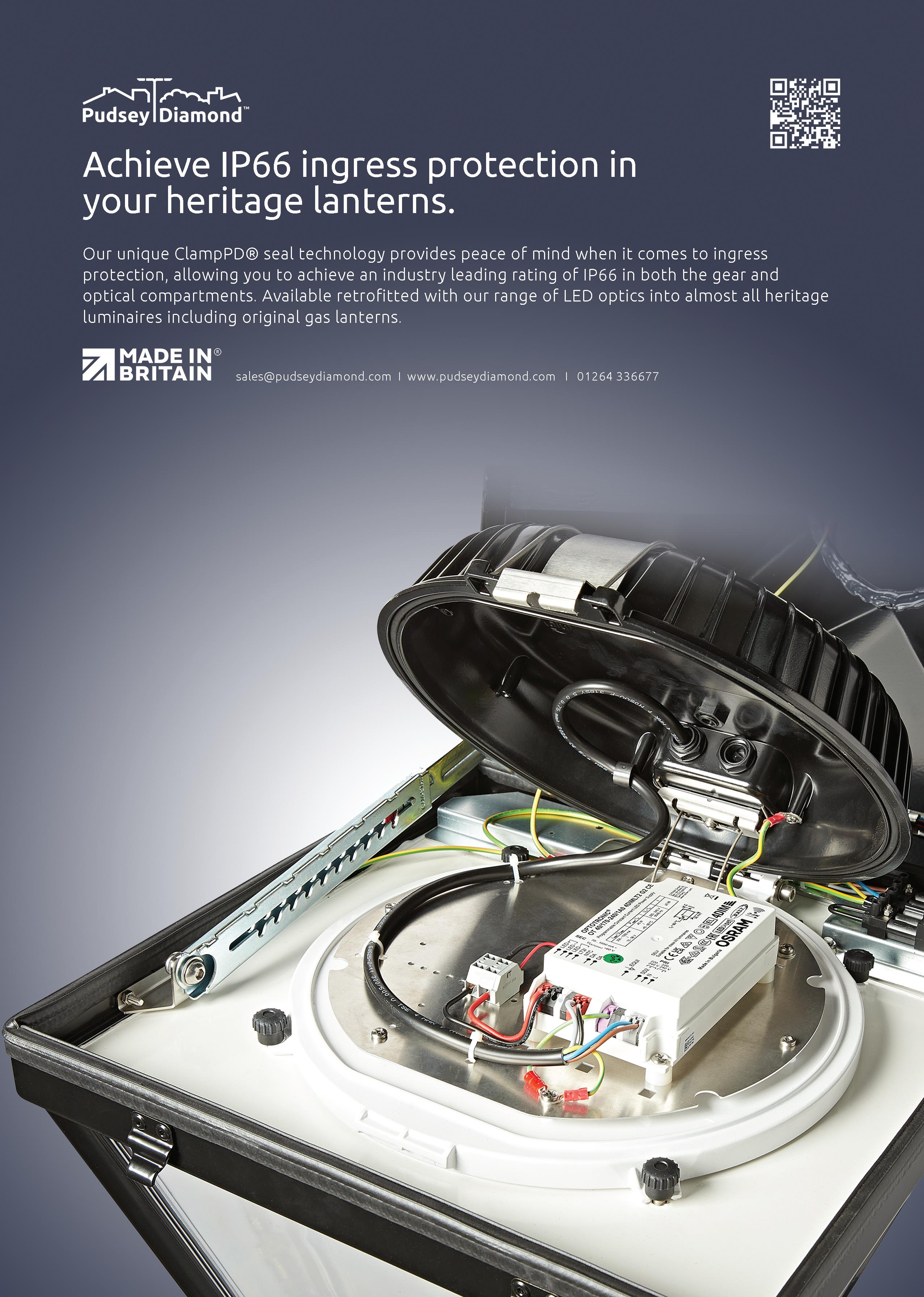


light of the outer walls designed to contrast with the warm interior and enhance the construction’s visual expression. But getting to that point required a lot of trial and error.
‘When we started the project, we didn’t have any samples of the metal. The architect just said, “well it’s kind of like the metal on your laptop”, which wasn’t hugely helpful. So, we started trying to test different light colours – we used the kitchen surface in our office, even the microwave,’ Arve explains.
‘By doing lighting tests on the microwave in our kitchen we managed to get a good indication of colour temperatures that would work well with the metal. We wanted to achieve the right contrast between a warm 2700K light and a cooler white light, reminiscent of moon light. We combined the 2700K source with different colour temperatures, 4000K, 5000K, 6000K. There was something about a combination of 2700K and 5000K that felt fairly naturalistic.
‘When we tested 6000K it turned into a blueish colour that was more theatrical and with 4000K the difference just wasn’t great enough; the contrast was too pale to 2700K. So this was the happy medium. That was also great for the products we got from LightGraphix, which we used for lighting the soffit outside, because 5000K was the standard.
‘For the wallwashers we got from iGuzzini, however, that was not so great, because they don’t do 5000K as standard, so we had to get a batch of LED chips custom made for the project, and integrated into the uplights.
‘To verify our scheme we did digital tests on a 3D model that we received and then also physically at the metal workshop, once the full first sample of the curved metal had arrived in Bergen. Purely based on digital calculations it’s impossible to predict exactly how the metal will react to light.


‘One of the great things is the light changes as you walk past the material. In some cases, it looks like it is picking up more light, in others it looks like there’s less light. It changes
gradually, which is quite interesting. But metal and lights are not easy to bring together.
‘We also did lots of tests on the doors, trying to figure the depth of them to get as uniform as possible lights on to them. In the end, the door details changed a bit and we ended up with a single side of light; it is not completely uniform. But that is still OK and it is a good way of getting some light into the
corridor space from which you’re approaching the toilets and also, from the same light source, getting light into the toilet area. It was an interesting learning experience,’ Arve adds.

TONED DOWN
Unsurprisingly, throughout, the lux levels have been kept as low as possible. ‘If you measured the lux levels on the ground you
JUNE 2023 LIGHTING JOURNAL www.theilp.org.uk 8
Top: the Espenes Rest Stop, looking out over Hardangerfjord. Above: the toilet facilities, showing the floor lamp steel and acrylic bollard

Architectural lighting
would struggle to get a reading, but you have to keep in mind that you’re surrounded by darkness,’ says Arve. ‘When you are standing looking out across the fjord, our lighting is not competing with anything. But at the same time, when your client is the roads authority, you assume they’re going to really care about lux levels and uniformity.
‘We were thinking “we are proposing to light this thing, which is 5m tall, with 2.4w of light per fitting? Is this going to fly? Will we get told off?”,’ Arve recalls.
The actual construction of the site was also challenging. ‘We went on site and eventually received all the metal panels. They came from China to Bergen – and there had been hold-ups and delays because by that point we were in the pandemic – and were then put on a truck and driven to site,’ says Arve.
‘It was like having a three-dimensional puzzle that the contractor had to figure out! And it was extremely cold as well. So I don’t think it was pleasant to install it, but they did a really, really good job,’ he adds.

The parking lot is not illuminated to limit the negative consequences of adding light to the area. As Arve says: ‘Usually parking lots are lit, but here it, sensibly, wasn’t. The prospect of adding 40 lux of lighting to the parking spaces would have ruined the project.’
What, then, has been the feedback to the project? ‘It has been good and bad from the local community, to be honest,’ concedes Arve. ‘In the end, there has been a lot of good feedback on the outcome of the project. But there was a lot of polarisation initially.
‘Some people argued the money shouldn’t have been spent on this sort of structure; some thought the money would have been
better spent on making the roads wider and safer, for example. But at the same time, it has brought economic benefits to the whole area with people visiting.
‘It is in the middle of nowhere but still the hotels were fully booked and very busy. They even have tourist buses coming through now every afternoon,’ he adds.
There has also been positive feedback in the sense that the project won in the ‘Structures – low budget’ category of the darc awards 2023, announced at the end of March, and the Norwegian Lighting Awards. ‘It has been very cool to win the darc award,’ says Arve, then referring back to the practice’s work on the island of Jørpelandsholmen, as also reported in Lighting Journal (‘Norwegiangood’, January 2021, vol 85, no 1).
‘There is something about projects like this – and the Jørpelandsholmen project was similar – that it is toned down. I think it so cool when these sorts of projects do well in awards. Instead of shouting louder you are whispering quietly, yet people are actually interested to hear what you have to say,’ he says.
TRUSTING YOUR DESIGN
What, finally, are his takeaways, his learnings, from a project such as this? ‘For me, what pleases me the most, it was that in the end we dared to keep everything really pared back and definitely not over-light anything,’ says Arve.
‘It is about trusting in our design. There were a lot of things that felt risky and controversial at the time, as we were doing them. You start to worry about the amount of light you’re putting in; you start to worry about the reflections; are the highlights on the metal going to look OK; is it flat enough; too shiny; what about the shadow, is that going to be distracting; or, very simply, is this just going to look stupid?
‘So for me it has reaffirmed the importance of keeping faithful to your concept and overall idea; that has been really important. That we managed to avoid adding more elements to the scheme simply because it could feel tempting or ‘safe’.
‘The other interesting thing here was how few elements can we keep it to? With just the cold and the warmth, you understand everything in an instant. We try where we can to always have that kind of clarity in projects.
‘It is so easy to get distracted from the core idea and include just another element in your scheme until, in the end, you’re making the architecture less legible. By adding more light to a project you are actually taking something away,’ Arve adds in conclusion.
PROJECT CREDITS
Project: Espenes Rest Stop
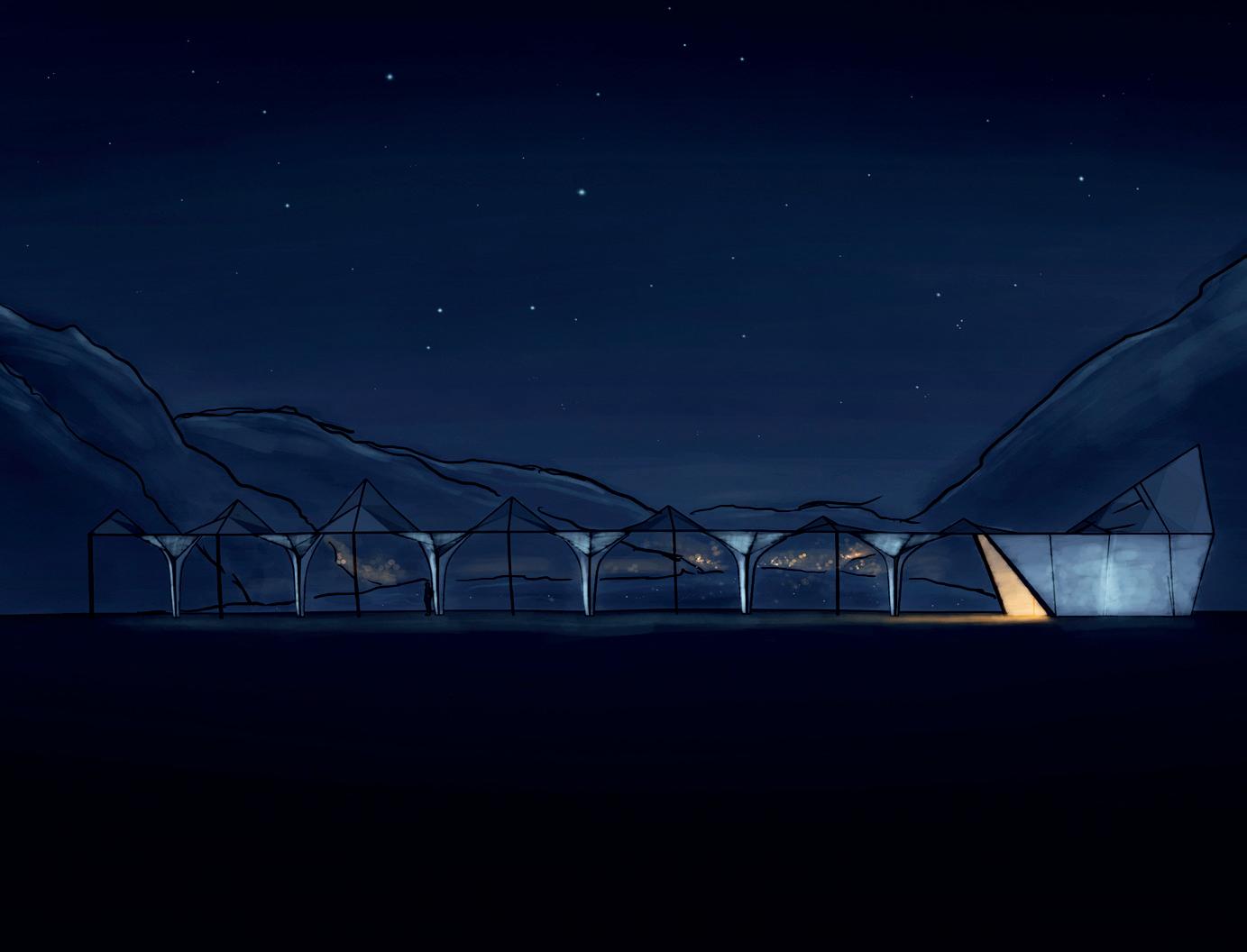
Location: Hardanger, Norway
Client: Norwegian Public Roads
Administration
Lighting design: Light Bureau
Architect: Code Arkitektur, Norway

Additional design: Norconsult (landscape design), DIFK DIPL-ING, Florian Kosche (structural engineer)
Lighting suppliers: LightGraphix, Stoane Lighting, iGuzzini, LED Linear

JUNE 2023 LIGHTING JOURNAL www.theilp.org.uk 10
One of the initial sketches for the project

Preserving Our Past
1976 dwwindsor.com Light Responsibly® Preserving the look and feel of historical lighting is both an art and a science. At DW Windsor, we have perfected this balance over many years to become industry leaders in the craft of lighting restoration. Wandsworth Bridge, London Historical lantern and column restoration and LED upgrade undertaken by DW Windsor
Lighting restoration experts since
‘IT NEEDS TO BE DEEDS NOT WORDS’
Does lighting have a race and ethnicity inclusion problem? Lighting Journal brought together a panel of lighting designers and engineers to grapple with what is a complex and challenging question, and consider how lighting can reach – and attract – a wider, more diverse population
 By Nic Paton
By Nic Paton
JUNE 2023 LIGHTING JOURNAL 12
Does lighting have a race problem? This was the challenging, and in truth provocative, question at the heart of a recent Lighting Journal panel discussion to debate how lighting, as an industry, is doing around equality, diversity and inclusion (EDI), in particular in regard to race and ethnicity.
The discussion brought together lighting designers and engineers representing a wide range of ethnic and cultural backgrounds as well as experience.
Our panel comprised Sanjit Bahra, principal and founder at DesignPlusLight; Brad Joseph, principal lighting designer at Hoare Lea; Kimberly Bartlett, head of lighting design at Introba and ILP Vice President – Education; Seraphina Gogate, principal lighting designer at Cundall; Elizabeth Thomas, public lighting manager at Walsall Council and ILP Past President; Katerina Xynogala, lighting engineer at WSP and YLP representative; and Jess
Lighting and equality, diversity and inclusion
Gallacher, the ILP’s Knowledge Transfer and Communications Manager.
So, first, what did our panel feel about this question? Did they agree? And, if there is a problem, are things improving?
‘When I came into lighting, it was a man’s domain,’ agreed Elizabeth Thomas, who was the first female and Indian President of the ILP. ‘It was very difficult to get into it. I did the exterior lighting diploma and it was all men, predominantly men. But we all got good grades, passed, came out and were good lighting designers and all kept in touch. All of us progressed, but it was really hard.’
‘My experience, and I pretty much joined lighting at the same time as Elizabeth did, would be the complete opposite,’ confessed Sanjit Bahra, who argued he was conscious he is still in the minority with the position he holds within the industry. ‘There were more women in the roles than men, but perhaps that was just about the area I was working in.
‘I think lighting design is a really unique profession in that, unlike most other design disciplines, we do not take the lead. We need to be given a canvas on to which to imprint our craft.
‘As a result, we meander and we mix within the light and shadow of the whole industry. We are actually representative of the wider industry. When you say does lighting have a problem, I don’t think that’s the real question. I think one has to ask, does the wider industry have a problem? We are reflections of the design industry. However, we are a young discipline and as a result it takes a while for representation to percolate up the chain.
‘There are more women of colour in our industry, but as yet still few men – especially towards the top tiers of lighting design. The UK invariably leads the diversity demographic, in our industry, in the Western hemisphere of the globe. I also understand and appreciate the privilege I have in making that statement.
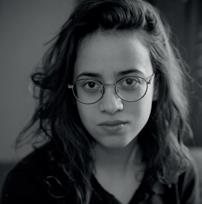


‘I think that’s because lighting is a tier within a tier in the field of design. People aren’t that aware of lighting as a profession. People of ethnic backgrounds may not be aware of, or feel that they have the right access, connection(s) or route into the profession and will have to, as Elizabeth said, ‘work and graft harder,’ Sanjit added.
‘I agree with a hell of a lot of what Sanjit says,’ said Brad Joseph, who is both a Black lighting designer and a proud Bristolian. ‘But I think, in terms of lighting design, it’s a societal thing as well. I was very lucky with my mum and dad that they encouraged my artistic nature; they thought I was good enough.
‘Friends who are the same colour as me, they didn’t get pushed in terms of doing what they wanted to do. It was just “I’m going to keep the parents happy”. So, it is multifaceted; you kind of need to start with society first.’
‘The first thing I learnt is that “diversity and inclusion” keep getting lumped in together. But they are two very different aspects of the way that society works,’ agreed Seraphina Gogate, who comes from a mixed Indian background.


‘The places I have worked at, they’ve been diverse. But if you look at the directors, they’re still often White, White men or women. It is not just lighting, it is typical of architecture, where you will have the younger millennial generation, which is normally quite diverse, and then the older generation, which is often more White and male,’ she added.
‘When you look at the documentation you get – including Lighting Journal and industry events – and you look at the photographs, it is often a long line of White men,’ agreed Kimberly Bartlett.


‘There are hardly any women, no men or women of colour; there are very few young people. And I think that is the biggest problem that we have, as the ILP. We’re showing the world the wrong side of us; we actually need to be showing our truly diverse group of people,’ she added.
SOCIO-ECONOMIC BARRIERS
However, the panel agreed it was harder to say whether this lack of diversity and representation is symptomatic of a specific problem within lighting per se or simply more a reflection of wider societal barriers or inequities, especially socio-economic barriers.
For example, while it’s by no means an excuse, the fact lighting is a young industry where the top cohorts will have emerged from a relatively small pool of pioneering people – often White, middle class and male – may help to explain its current lack of diversity at senior levels.
Equally, the fact lighting design espcially is predominantly a degree-entry profession (and often also requiring a postgraduate degree) can be an automatic barrier to entry for people from socio-economic disadvantaged backgrounds, both in terms of student debt and, simply, access to universities and higher education in the first place. This is even more likely to be the case for people coming to lighting from architecture, with its seven-year degrees.
The fact there are not many specific lighting or lighting design education programmes to choose from can, in turn, be a barrier in terms of access, geography, and
THE PANEL
Sanjit Bahra, Principal and founder, DesignPlusLight
Kimberly Bartlett Head of lighting design, Introba (formerly Elementa Consulting) and ILP Vice President – Education
Jess Gallacher ILP Knowledge Transfer and Communications Manager
Seraphina Gogate Principal lighting designer, Cundall
Brad Joseph Principal lighting designer, Hoare Lea
Elizabeth Thomas CEng, FILP, MCMI Public lighting manager, Walsall Council, and Past President, the ILP
Katerina Xynogala MSc BA(Hons) EngTech LCIBSE, engineer, lighting and energy solutions, WSP, and YLP editorial national committee representative
www.theilp.org.uk JUNE 2023 LIGHTING JOURNAL 13
Lighting and equality, diversity and inclusion

(again) money or financing. Moreover, even if the cohorts coming through such programmes are, notionally, increasingly diverse, if you’re all the time only drawing from a few, select universities is your industry in fact diverse in terms of its thinking or outlook?
On top of all this, as Brad highlighted, there is the issue that lighting (again lighting design especially) is unusual in being both a technical and creative/artistic discipline.
While this is one of its key attractions, it can also potentially act as a deterrent, again especially for those from more disadvantaged backgrounds. This is in terms of both needing to get good grades in ‘harder’ academic subjects, such as physics or maths, and, as Brad highlighted, the idea that ‘creative’ or ‘artistic’ careers may not be considered viable options, especially in terms of quick earning potential.
Then, more widely, there is the well-documented problem of lighting often not being visible as a career option within schools, colleges or even universities. This is something that, again, is more likely to disadvantage those from socio-economic deprived backgrounds, who may have fewer options or opportunities open to them to start with.
SYSTEMIC, CASUAL RACISM
The discussion also highlighted just how systemic casual racism can be for people of colour. The panel, to be clear, all felt this was not necessarily something specific to lighting (though sometimes can be) but simply part and parcel of being a person of colour navigating different cultures and countries.
For example, all our panellists had experienced the notorious ‘where are you reallyfrom?’ question.
‘I don’t look exactly Indian but I also don’t look exactly anything else,’ explained Seraphina Gogate. ‘So my race becomes a topic of discussion once people become comfortable with getting to know me. It’s got nothing to do with the project; it’s got nothing to do with anyone else. But everyone is a little bit curious – where exactly do you fit in on the scale of Brown?’
‘I get this too because of my accent,’ agreed Katerina Xynogala.
It’s tricky to determine how much of the normal ‘sizing up’ of who you are that invariably happens when you enter new spaces relates to the colour of your skin, said Sanjit Bahra. ‘I get very different responses and reactions depending on whether I open my mouth – the accent that comes out. I see this shifting of “where do we put him on our scale of privilege and access?” that happens. It’s part of who we
are as a society and still includes colour as part of that judgement. Of course, this is ever-evolving and will differ greatly from culture to culture.

‘Similarly, you walk into a room for a meeting and everyone is visual, so they want to know “what is this person, where do you fit in my assumptions of where you are from?”. Sometimes the “where are you from?” is just an innocent question but it can be tiring,’ Sanjit added.
‘A lot of people ask me, “what is your Indian name?”,’ also agreed Elizabeth Thomas. ‘And I say, my Indian name is Elizabeth Thomas! But then they’ll say, “shouldn’t it be something else?”. We are Christians and it is a very common name in India. Why should I not have the name Elizabeth Thomas?’
‘My name – Brad Joseph – that sounds like a White surfer dude. It’s weird isn’t it. It’s like a cultural shift, people think, “no, that’s not right”. I’ve had it so many times, and it is just so frustrating,’ echoed Brad Joseph.
‘Growing up I was quite dark skinned, a deep olive,’ said Kimberly Bartlett. ‘Years of hiding inside have lightened me up so now I find that mostly I can pass; they expect to see a White person when they see my name; I am for all intents and purposes a White person. But when I was younger I had experiences all the way through of people not believing who I was or what was going on.
‘For example, I had my car broken into and the police officer said, “what ethnicity are you?” and I said, “White” and he looked at me like “really?” so I changed tack to “mixed European” but he put down Indian. And I was like, I was born in Stevenage!’ she added.
‘One of my teachers at university told me, “your product is like an onion, but I’ll explain it to you in terms that you can understand – it needs to be like an onion
bhaji”. I remember that so vividly,’ said Seraphina Gogate, to gasps around the panel.
POSSIBLE SOLUTIONS
What, then, might help here? How can lighting improve its diversity and representation? Is it a question of more, or just different, pathways to entry, such as apprenticeships and different university-level entry models? Is it more role models from ethnically diverse backgrounds? More visibility in schools and colleges? Visibly more diverse events, awards, panel discussions and publications? All of the above?
‘I think lighting needs to be a vocation; it needs to be a job that is known and experienced by kids of all ages,’ said Kimberly Bartlett. ‘At the moment it is one of those dark arts where people don’t even know that it happens. There are probably about five people that I know who actually wanted for their whole life to be a lighting designer. Everyone else has just dropped into it by accident.’
‘I think one of the beautiful aspects of our profession is that there is a natural diversity of skills and perspectives,’ replied Sanjit Bahra. ‘You will get a team of lighting designers around the table and not one of them has had the same route in. That in itself brings an openness and fresh mindset.
‘So maybe what we do is we advertise the profession ongoingly to the wider world and say this is what lighting design is. This is the wider diversity of the professional entryship into it. And make a conscious effort to showcase the diversity across all aspects of the profession, be it gender, colour, (dis)ability – elevate and educate the wider design world as to who we really are,’ he added.
The ILP, Kimberly Bartlett pointed out, is working with the Worshipful Company
JUNE 2023 LIGHTING JOURNAL www.theilp.org.uk 14
Smart integrated solutions to protect people and places.
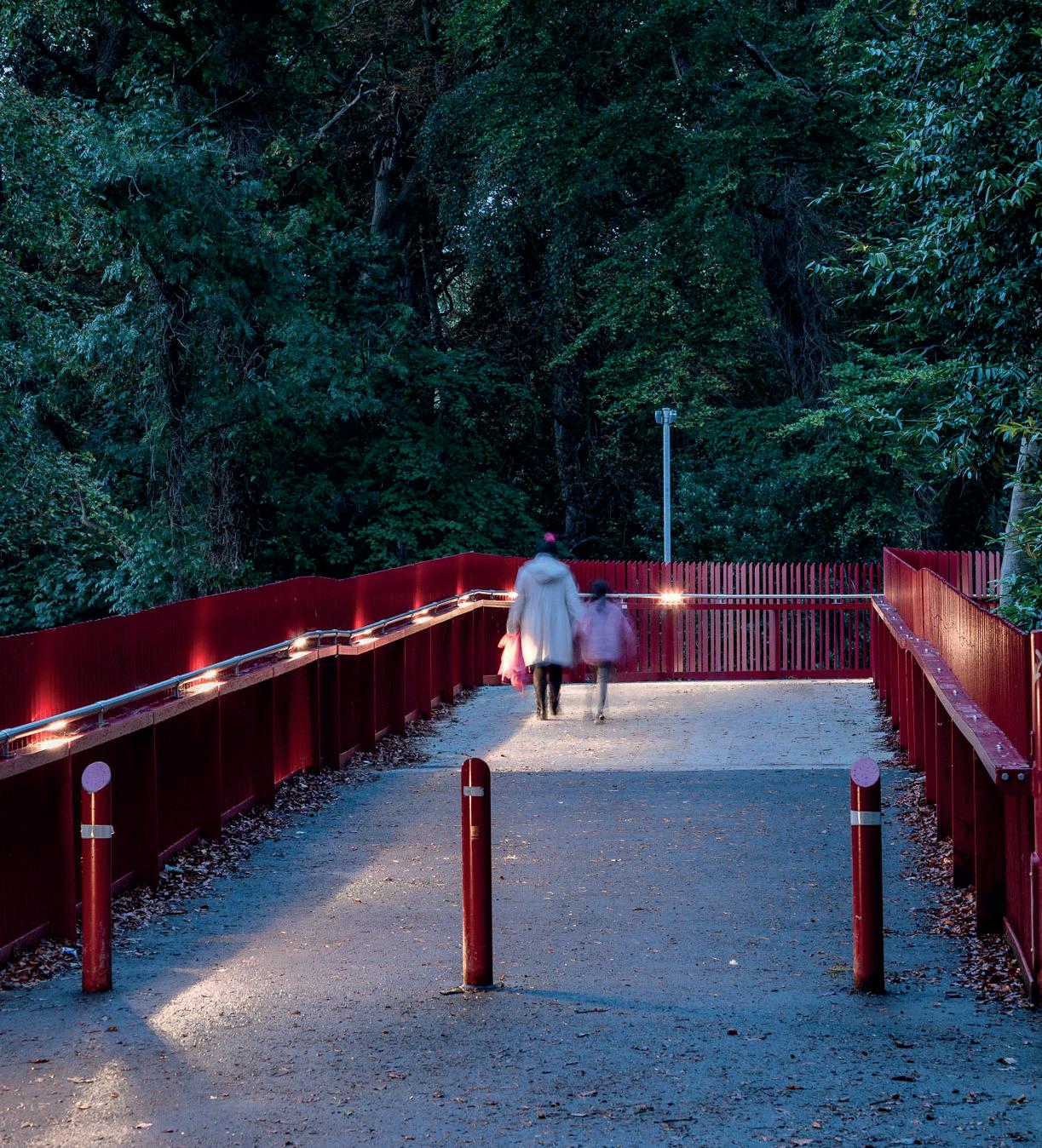


































































In some circumstances ‘darkness itself can promote the fear of crime’ - Police Crime Prevention Initiatives (PCPI). And although lighting can’t prevent or ‘design out crime’, with the right solution - considering all scenarios, light levels, ecological impacts etc. - we can make smart, intelligent choices to create a welcoming environment that people feel safe in.
Lighting for safety also means thinking about what people actually need. With Schréder’s EXEDRA, we help clients achieve all the above, plus decarbonisation, with endless adaptability through our control system that allows us to monitor, meter and manage in a lighting network. Whether you’re after a dimmabe, sensor or bespoke systems to adjust light levels, Schréder’s EXEDRA is a connected-ready CMS that meets all your needs.









Talk to us about making the right connections and how we can help YOU create spaces and places that protects people. Get in touch at logic@urbis-schreder.com Urbis Schréder 360° lighting with WLAN Loudspeaker SOS Intercom PIR sensor EV Charger
- Building confidence in outdoor areas.
| |
Lighting and equality, diversity and inclusion

of Lightmongers and various sister institutions to create a lighting apprenticeship via the government’s ‘trailblazer’ apprenticeship reform programme.
While it is early days, this will probably be pitched initially at Level 3, so essentially an A Level-type qualification. ‘That seems where most colleges, most students, seem to be more inclined to apply to. That gives them that grounding and foundation to then look beyond. However, in discussions with some other groups, like the IHE [Institute of Highway Engineers], we might be looking to go up to Level 8, so all the way to master’s,’ Kimberly said.
‘Personally, I think if you can get that Level 3 that gives you that foundation to actually apply it within the workplace and learn both ways. So, you do the theory and you do the practical at the same time,’ she explained.
The ILP is also working on how it can widen access to the Exterior Lighting Diploma (ELD). ‘The ELD as things stand is not a registered qualification, which is something we are looking at. Currently, although you do find some councils that say, “must have ELD”, it is not a recognised qualification,’ Kimberly outlined.
‘If it can become a registered qualification, then it can have credits applied to it and it can be used within other frameworks of learning. So, for example, you could add it to an apprenticeship or use it as a unit within a degree and things like that. We are trying to get traction down that route if we can.
‘Once we’ve done that, the ELD will start turning up on lists of qualifications, which makes it much more visible. It becomes a course that has more value. If we can get it to the point where it is a recognised qualification, that removes so much wooliness from it. It is suddenly “this is a person who knows what they’re doing”,’ Kimberly added.
‘The advantage of an apprenticeship would be that the students are more likely to be being mentored by people like us. The difference between that and going to university is that, often, the people who are teaching you are that older, White, male population,’ agreed Seraphina Gogate.
‘I wish I could have done an apprenticeship,’ echoed Katerina Xynogala. ‘But I come from a European background – in Greece – where everybody has got a degree. In Greece there is even a degree in cheesemaking! Everybody goes to university.
‘I came to the UK and I wished I had had the option to go for an apprenticeship. I appreciate my degree and what I learnt through it, and I appreciate the fact I’ve had the chance to learn about various different things. I studied drama theatre arts
originally, because I wanted to be an actress and a dancer,’ Katerina continued.
‘I ended up working in lighting because I realised I preferred to work in that industry. But when I started working at WSP I used to feel at a disadvantage in comparison to everybody else because I didn’t do an engineering degree, with all the accreditations that it brings.
‘I think apprentice routes are great. I think more and more of them should exist. But I also think opening up pathways to graduates who maybe don’t have an engineering background, or who have different experiences and different knowledge in different areas, would help,’ she added.
Katerina also made an important point that, in some respects, the experience of the pandemic has helped to make all industries more inclusive, transparent and open. Hybrid and digital working models, for example, can sometimes take geography out of the equation when it comes to accessing a career.
‘At WSP, I was very lucky, in a weird way, because I started during Covid,’ she pointed out. ‘Covid forced people to get online and we had all of those weekly meetings where the team came together online and just spoke about their lives. Or lack of lives I guess at that point.
‘That for me was so helpful in terms of getting to meet people, even if not face to face, and understand a bit better about what people’s interests are, and how they function, but with the safety net of talking from a camera. So, actually, my experience was very positive because in-person meetings then slowly got introduced.’
ROLE OF INDUSTRY BODIES
What role, too, can – or should – professional bodies and institutions, including the ILP, play in this, the panel was asked.
‘I have probably an unpopular opinion about that,’ said Kimberly Bartlett. ‘There are too many institutions trying to split things apart into too many little boxes. And everyone is fighting with each other to try and be the one that does this course or that qualification.
‘What is the point in having two people doing the same thing? What is the point on doubling up on everything, it makes no sense? Why are we fighting and trying to pull members from each other when, actually, we should be working together and bringing the future generations on through our collaboration together?’ she questioned.
‘The current situation isn’t how you would set it up if you were setting up institutions from scratch,’ Jess Gallacher answered. ‘But the reason we’re at where we’re at is because there are things behind it. For example, the
JUNE 2023 LIGHTING JOURNAL www.theilp.org.uk 16
Lighting and equality, diversity and inclusion

ILP is a charity, we exist to the benefit of the public, we don’t exist to the benefit of the members.
‘The Lighting Industry Association, by contrast, exists for the benefit of their members, so they have a different reason for doing things – they want to help them make a profit. We care about the impact our members have but the reason the ILP exists is to share knowledge that helps the world be lit or darkened in a way that is better for people and planet and everything on it.
‘We do always collaborate with others who either have the same objectives or where a project where our objectives align.
With the Society of Light and Lighting for example, Brendan [secretary Brendan Keeley] and I often confer with each other so that we don’t compete. Similarly, we talk frequently with the IALD. I think lighting is a small enough industry at the moment so that we’re not duplicating work,’ she added.
As the discussion drew to a conclusion, the panellists were asked to suggest one thing that they’d like to see change or which they felt, if it did change, would help to make a difference.
It was up to the industry to be going out and taking the message about lighting as a become more visible, argued Brad Joseph.
addressed [2]. Many of the report’s conclusions echo what our panel felt and had experienced in their careers. Its key conclusions included:
DIVERSITY WITHIN ENGINEERING
Engineering UK’s Engineering in higher educationreport, published in March, highlighted that just 18.5% of engineering and technology first degree undergraduate entrants are women, low compared to 56.5% female intake of students across all subjects [1]. It added that:
• Representation was higher on engineering and technology postgraduate courses (25.8% of students on taught courses and 27.8% on research courses were women) but remained much lower than in the total student population.
• Engineering and technology degrees do, however, have a higher proportion of minority ethnic entrants than other subjects. Most notable were the higher percentages of Asian students studying engineering and technology at all levels compared to all subjects combined.
• Just 10.5% of engineering and technology first degree entrants had a known disability, compared to 15.1% for all subjects combined, said Engineering UK. For postgraduate study, percentages of entrants with a known disability were lower still at 4.2% and 7.3% for taught and research courses respectively.
On socio-economic diversity, this was something the Bridgingthegapreport from The Bridge Group, published in February 2022 for the Sutton Trust, specifically
• Engineering is by and large diverse but is hampered by a split between students taking ‘vocational’ and ‘academic’ routes into the profession. This potentially creates a two-tier structure whereby students from lower socio-economic backgrounds are more likely to take a vocational route, which confers fewer opportunities for progression. Conversely, those from higher socio-economic backgrounds are more likely to take academic routes into the profession, which are typically higher status, and often better paid.
• While the ‘class pay gap’ within engineering is smaller than within most other professional sectors, in professional engineering roles there remains ‘a significant gap’. Within engineering, those from higher socio-economic backgrounds are much more likely to progress to higher managerial and professional roles.

• Because engineering is highly skilled and technical, this generally makes it more meritocratic and socially inclusive than some other professions, such as law. Yet, at the same time, there can still be a perception that someone needs to ‘fit’ as a basis for progression and advancement. Educational advantage, the ability to develop networks and the benefit from informal sponsorship ‘is unevenly distributed, and favours people from higher socioeconomic backgrounds’.
• Overall, while engineering compares favourably against most other professional sectors in relation to socioeconomic diversity and inclusion, there are still inequalities in access, progression and pay.
www.theilp.org.uk JUNE 2023 LIGHTING JOURNAL 17
Lighting and equality, diversity and inclusion
‘I think it’s about us going to the places where you least expect creativity to thrive. If we try to push that, the industry will become more successful and attractive.
‘My mates used not to have a clue what I did “you just tell someone where to put the lights?”. But then they saw what I did and it was like “wow”. If we look for the areas where we least expect creativity and design to be valued, we will take it forward,’ Brad said.
‘I think this is a complex issue, so to say there’s one thing that will shift things around is difficult,’ said Katerina Xynogala. ‘But maybe, for me, more advertising in universities and not just into specific degrees for lighting. There are people with varying backgrounds who may actually find the industry very interesting, even though they might not be engineers or come from a STEM degree.’
‘For me, there is more positive than negative in this,’ said Elizabeth Thomas. ‘I think the ILP, for example, has come a long way but there are still not enough of us, there is still not enough diversity.’
GETTING DIVERSITY INTO LIGHTING’S DNA
For Seraphina Gogate, it was about the industry doing more to build equality and diversity into its DNA. For example, the need for panel discussions always to have a diverse make-up and for industry awards
THINGS THAT CAN MAKE A DIFFERENCE
The HR body The Chartered Institute of Personnel and Development (CIPD), in its Inclusion and Work 2022 report, advises that inclusion should not be an add-on or tick-box or something that is only focused on in the good times [2]
An organisation’s structures, culture, policies and standards of behaviour all need to be designed with inclusion in mind, with everyone in an organisation appreciating they have a role to play in making this a reality, it argues.
Organisations need to focus on inclusion and equality alongside just hiring a more diverse workforce, as without all three being aligned, the chances are that people won’t stay within the business.
Recognise, too, that initiatives to encourage more inclusion (for example more flexible working patterns to accommodate those with caring responsibilities) will often benefit
to recognise, and reflect, diversity and inclusion, even for more awards to celebrate and reward diversity and inclusion in itself.
‘If you got an actual plaque or trophy; if there was a diversity award within lighting awards. That could on one hand reward the person but on the other start a conversation around why is this award even needed? So maybe, yes, an award would be good,’ she said.
‘From my point of view, visibility is the biggest element that could, I think, make significant change quickly. It is making sure that everything that goes out from the ILP, for instance – everything that goes into the public realm – has as much diversity as possible within it. We need to make sure we have – and are showing – the multitude of us,’ said Kimberly Bartlett.
‘It is such an enormous topic. I do think there is an element that we all need to do better and take some responsibility for this, educate ourselves,’ emphasised Jess Gallacher. ‘There are things you can read about this subject. So don’t sit around waiting for someone else to tell you how to do better. Just go out there and do better yourself.’
‘I agree with Seraphina, some sort of award, just to say “thisperson is here taking up space”,’ said Sanjit Bahra. ‘If you actively take up space, it forces a conversation as to why this particular award is there in the
everyone within an organisation not just those they are notionally targeted at.
More diverse and inclusive organisations will often be more collaborative, more creative and innovative (in that they are less like to run the risk of ‘group think’), more transparent and open, more reflective of the communities or clients they serve, and, as a result, more effective and productive.
The CIPD highlights seven things that, if put into practice and genuinely embraced, can make a difference:
1. Build an evidence-based long-term plan or strategy, which includes measures to track progress.
2. Take a data-driven approach to gain buy-in, investment and maximum impact. Regular, ongoing employee feedback and surveys – so knowing what’s happening, changing or where there may be issues or problems – is vital.
3. Critically review and assess your
first place. Inclusivity needs to be much wider and I feel we are the industry to showcase this.
‘I see on Instagram and the design press all the talks and design panels – it’s still very homogeneous and with very little lighting design presence,’ he added.
It also could be valuable to create a pool of diverse people willing to put themselves forward to take part in events and panel discussions or give talks, a ‘speaker squad’ as Jess Gallacher put it.
‘We all need to go in and basically say “hello, you need us”,’ said Sanjit Bahra ‘That will elevate the lighting design industry as well as “showing a bit more colour”. My ethos has always been “if one of us wins, we all win”.’
‘But the last thing you want is for this to become an echo chamber,’ cautioned Brad Joseph. ‘It’s got to be not just all of us agreeing with each other. We may need to think outside the box to solve the problem.’
‘Absolutely, what I don’t want is to just keep having the same discussion over and over again,’ enthused Sanjit. ‘It needs to move forward. It needs to be more than just talking about it.’
‘By teaching people what we actually are and what we can bring, that allows us to cement our place in the industry,’ agreed Kimberly Bartlett in conclusion. ‘I’m going to paraphrase the suffragettes here, but it needs to be deeds not words.’
people management approach through an EDI lens.
4. Enable managers, including through job design and training, to fulfil their key role in creating inclusive workplaces. It can be a good idea to include EDI in performance metrics or key performance indicators, such as appraisals and performance development reviews, as a way to focus minds and ongoing engagement.
5. Support leaders to champion EDI and hold others accountable; have visible role models at all levels of the organisation.
6. Tailor your EDI approach to your organisation and sector context.
7. Take a long-term view and recognise something like EDI is never ‘job done’, so don’t take your foot off the pedal.
[1]
JUNE 2023 LIGHTING JOURNAL www.theilp.org.uk 18
‘Engineering in higher education’, Engineering UK, March 2023, https://www.engineeringuk.com/research-policy/educational-pathways-into-engineering/higher-education/ [2] ‘Bridging the gap: socio-economic diversity in the engineering sector: access, pay and progression’, The Bridge Group, February 2022, https://www.suttontrust.com/our-research/bridging-the-gap/ [3] ‘Inclusion at work 2022: findings from the inclusion and diversity survey 2022’, The CIPD, December 2022, https://www.cipd.co.uk/Images/inclusion-work-report_tcm18-112950.pdf
A
7kW on-street charging solution designed to make life easy-peasy

Can be retrofitted on to any column
15mm
Interoperable with all market-leading software
OCPP compliant
Onboard PEN device
Designed and manufactured in the UK

For more information contact hello@evpzee.co.uk or visit: evpzee.co.uk

‘WE CAN BE A STRONG, INDEPENDENT INDUSTRY IN OUR OWN RIGHT’
When we talk of the future of lighting design we often focus on changes in technology or science. But lighting design is also changing fast in how it works, who it works for and, just as importantly, who works for it
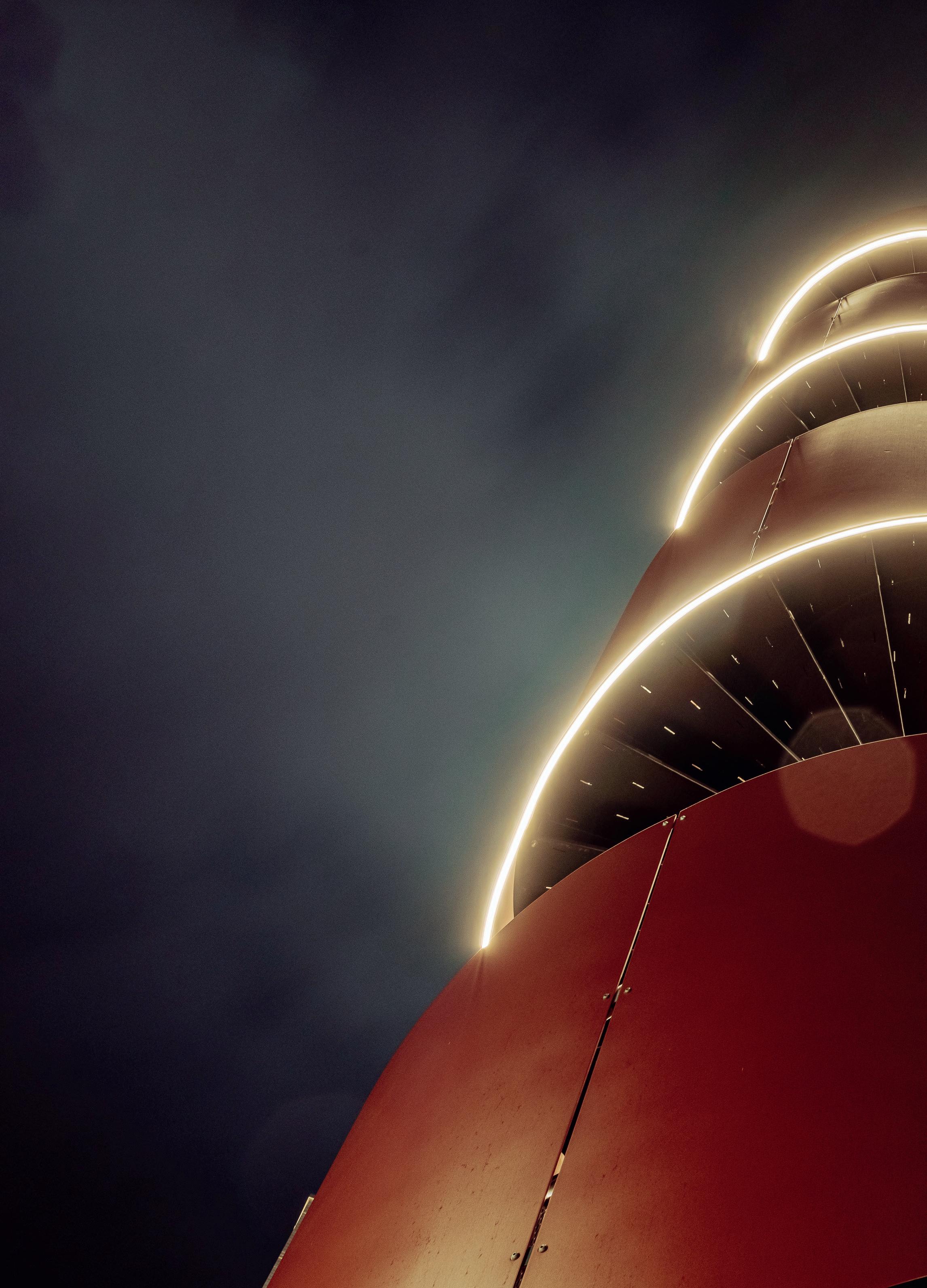 By Michael Grubb
By Michael Grubb
We all know it’s perilous to try and predict the future. There are often things you can hazard an educated guess about. Take LED, we all knew the LED revolution was coming, it was just a matter of when the technology would become scientifically up to scratch enough so to become commercially viable so that it ticked all the right boxes.
Yet, especially when it comes to cutting-edge science and technology, it’s really hard to get predictions right and there are people way more qualified than me who can do that.
In this article, I therefore want to focus on what I’ve been noticing in terms of where the lighting design industry appears to be going. Things that are already beginning to change how we work and will, I suspect, in time have the potential to lead to profound change.
REMOTE WORKING
First, we all know how, when and, most importantly, where we work has changed out of all proportion in the past three years. Yes, we all have a love/hate relationship with remote working, yet while face-toface meetings still have an important place, the truth is I can now dip into a half-hour conversation anywhere in the world, anytime of day – and then have perhaps four or five in a
day – rather than, say, having to get on a train or jump on a plane.
That’s not just made things a whole load more convenient and international, I’d argue it’s beginning to change the very way we work within lighting design too. One of the things that used to happen a lot – and still does a bit – is that you’d have a big client/ project meeting where we’d all have to be there.
JUNE 2023 LIGHTING JOURNAL 20
Lighting design
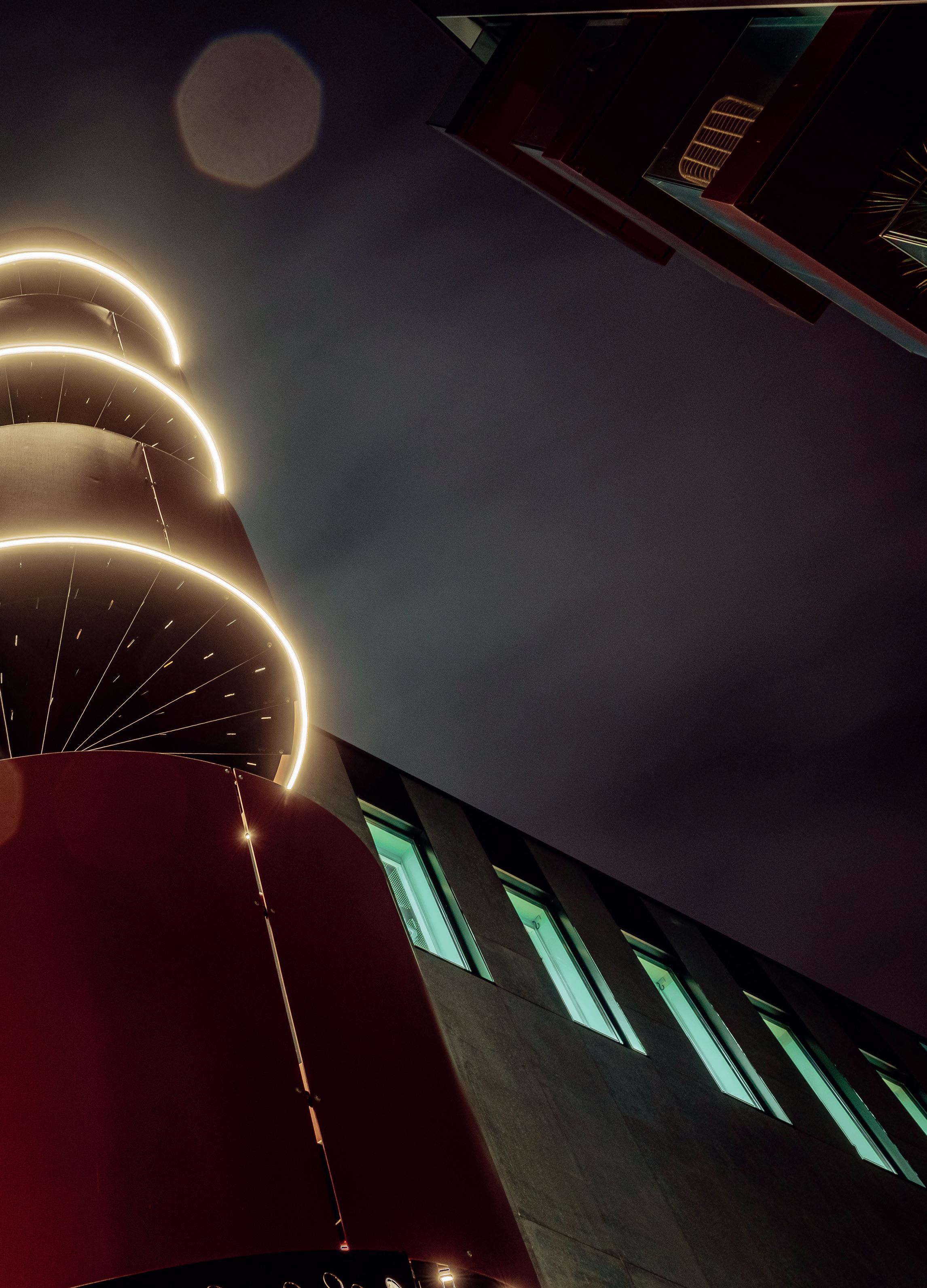
It might go on for five or six hours and the lighting design section on the agenda would be just half an hour. But we’d be there for the whole lot. We’d be sat there politely listening; it’s not that it wasn’t relevant, just that large chunks of it would probably be more interesting than relevant. Then, when you got to the lighting design session, you’d have to have it collectively, even if certain people in the room weren’t as involved in that part of the discussion.
Now we’re in a position not just to do the meeting virtually but, within that, break away into little virtual rooms and say, ‘let’s do a creative workshop on this’ or ‘let’s have a technical workshop on that’. And this, I would say, has changed the dynamic of how lighting design works.
Lighting design used to be very linear within the sector. So, it would be architects, landscape architects, and interior designers working with us. We’d then maybe go away and sit down with the engineers. And then manufacturers would come in with the sandwiches and try to sell us stuff, at which point we might also talk to them about a specific project.
What I’m finding much more now is that everybody is being embedded into these calls, often from much earlier on.
So, manufacturers, for example, are coming a lot more into our conversations; they’re
a lot more visible than they have ever been. That is something I think is going to move forward in the future.
LOOSER PROCESS
Another change we’re seeing emerging as a result is the planning and design process becoming looser. What do I mean by that? It’s that the briefs we are being given are often much more ‘you tell us’ or ‘what do you think?’ rather than us being told or instructed what to do.
For example, we’re currently working on a project where we’re clearly going to be doing testing – demonstrations and trials – in the construct and build phase. That means it can’t be accurately priced, accurately designed; loadings, control systems are all going to have to be fairly flexible through some of the earlier design stages.
I don’t think that is a bad thing at all, moving away from a rigid system. Equally, the international ways of doing things are becoming more flexible. But what it does mean is that we as designers are going to need to be more nimble than we’ve ever been.
Another change I’m seeing is in conversations with clients about what lighting needs to be for. The science of light, we’ve always understood, is about it being used in a ‘for the greater good’ way.
www.theilp.org.uk JUNE 2023 LIGHTING JOURNAL 21
This page and throughout this article: images of Michael Grubb Studio projects. This image: the Circus Street Development in Brighton
Lighting design

We’ve all known about the links between lighting and health, whether it’s hospital lighting or SAD (seasonal affective disorder), better lighting in schools, human-centric lighting or biophilic lighting and so on.

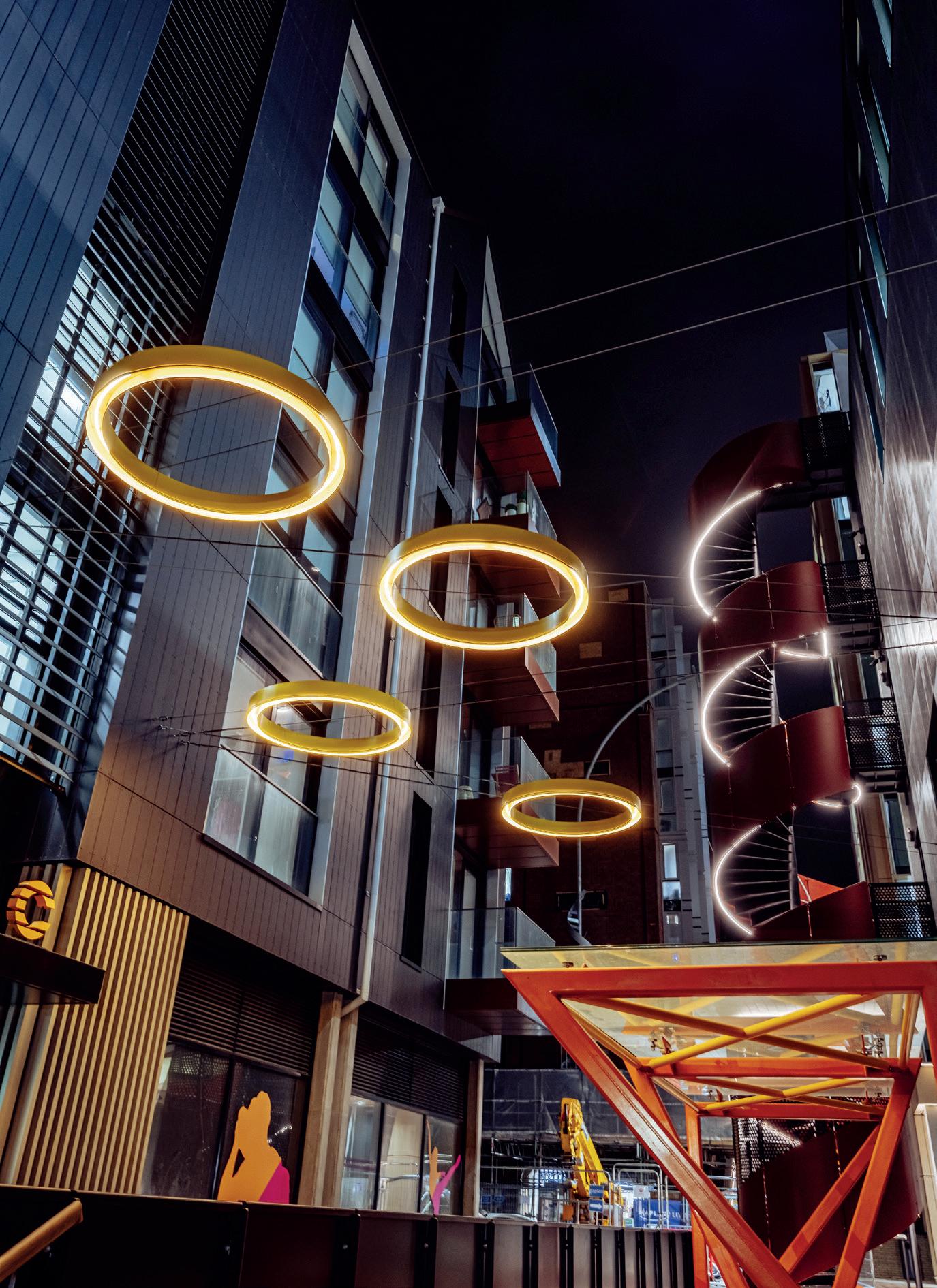
We’re now beginning to have some really interesting conversations around using light to enhance performance. How to use light and lighting to get an extra percentage of performance out of, say, toplevel sports teams.

I recently met the sporting director of a Premier League football club, who said ‘if you can improve our performance by 1%, there would be no budget level that you could spend at our football club’. After all, they’re spending £70m to £80m on a player and there’s no guarantee that investment will necessarily pay off. So, if you can put a new lighting scheme in the changing room that you can show will improve performance by 1%, there’s going to be no stopping the budget.
With anything like this of course, the really difficult question to answer is how quantifiable is this? How much difference can lighting reallymake? But I do think we’re going to be having more of these types of conversations.
JUNE 2023 LIGHTING JOURNAL www.theilp.org.uk 22
This page clockwise from top: Circus Street and (bottom two images) and Whitfield Gardens in London






























INTRODUCING THE ALL NEW Holophane’s most comprehensive streetlighting solution to date. Contact us: info@holophane.co.uk www.holophane.co.uk Footpaths Residential Roads Main Roads Highways Footpaths residential roads main roads highways
Lighting design
ROLE OF THE LIGHTING DESIGNER
Brands are now using light much more as a language, as something much more integral to their branding and the experienceof their brand. The days of lighting being just an afterthought are, I’d say, definitely disappearing fast.
This then leads to that timeless question: when should a lighting designer get involved in a project?
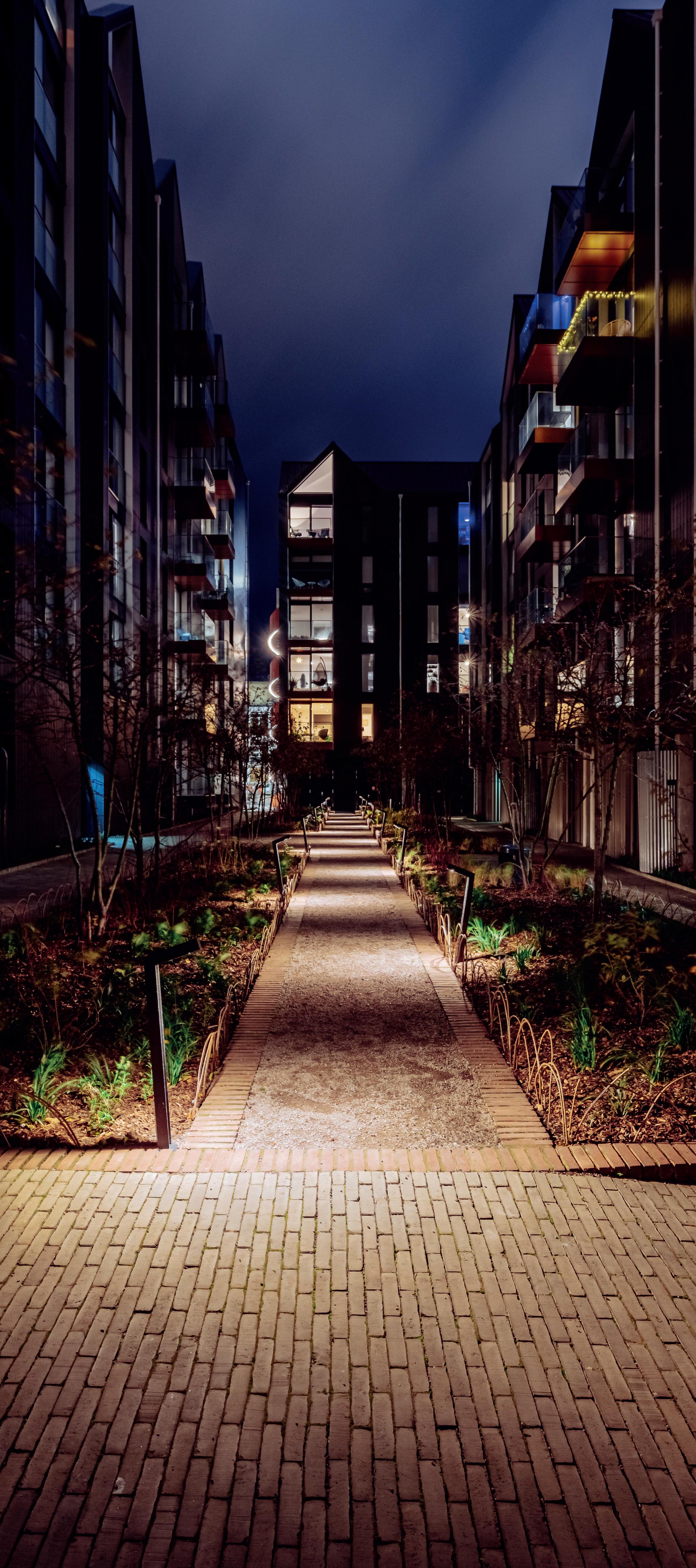
We all know it used to be that, too often, we’d be brought in too late; we were always an add-on, we were always upsetting the design because we were trying to weave our ideas into a package when it was already a bit too late. No architect wanted to redesign their building to incorporate some fancy lighting ideas.
This, I’d argue, has been and gone. We now get involved quite early in most of our projects. In fact, in nearly all of our projects the brief has required a lighting designer from the outset. We are acknowledged as an integral part of the design process.
Even more than this, what we’re now starting to see is the lighting designer having other disciplines working for them. We were always the sub-consultant; now we’re at the point where we need sub-consultants.
Projects can go in strange directions. So, it might be programmers or software specialists. Another thing we’re finding we’re needing a lot more is graphic designers to work with us on and for content.
So, suddenly we’ve gone from being sub-consultants, where we’re under the wing and conditions of the primary contractor, to becoming much more project leaders. That, I suspect, is going to change the dynamic of how we do things and how we work.
If you were evaluating a lighting tender, not that long ago it would be that you were comparing apples for apples, in the sense that most of those tendering would probably be pricing for pretty much the same thing. There would be minor differences but, realistically, whoever was picked you’d be getting the same service from.
Now, with things evolving so fast and so many different people, skills and disciplines involved, that’s changing. Even just presenting tender pitches has changed out of all recognition, let alone what’s included within them. We’re looking a lot more at using AI and VR in our pitches, for example.
When we did Battersea Power Station’s Lift 109 (as shown in last month’s Lighting Journal), for instance, I’m still disappointed we weren’t able to do a virtual reality mock-up. It’s a lift; there wasn’t going to need to be much space to move around and it wouldn’t have taken much to animate it. But I can’t believe that’s not going to be the default in five years’ time.
With BIM, that technology is allowing
JUNE 2023 LIGHTING JOURNAL 24 www.theilp.org.uk
This page: Circus Street. Opposite page: ‘Lightplay’ at Royal Terrace Gardens, Torquay
things to happen. But it is a bit like when CAD first came out; unless you all do it, it is a waste of time. So, I think what’s going to happen is there will be a breakaway of the forward-thinking consultants working with the forward-thinking architects and clients.
If you’re not trained and educated in the software and the opportunities of that, or if you don’t have the external support in terms of a consultant who you can trust and work with reliably, you’re potentially going to get left behind.
We’re all going to have to start looking at investing in different skills and disciplines, whether that be programmers, software specialists, graphic designers, ecologists, or whoever. The network of skills we need to be able to draw on is expanding all the time.
CONCLUSIONS
Finally, what all this means, I think, is that, as lighting professionals, we no longer need to be attached to another industry constantly to survive; we no longer need to think ourselves as simply as adjunct to, say, the architect or engineer or planner. We can be a strong, independent industry in our own right, with people attached to and working for us, with us being ones hiring the people. Even architects!
Of course, in a lot of the big lighting design departments within multidisciplinary practices, they never started with lighting. They always started with engineering, architecture, urban planning, with lighting as a gap to be filled within that. That, I think, is going to be the big change.
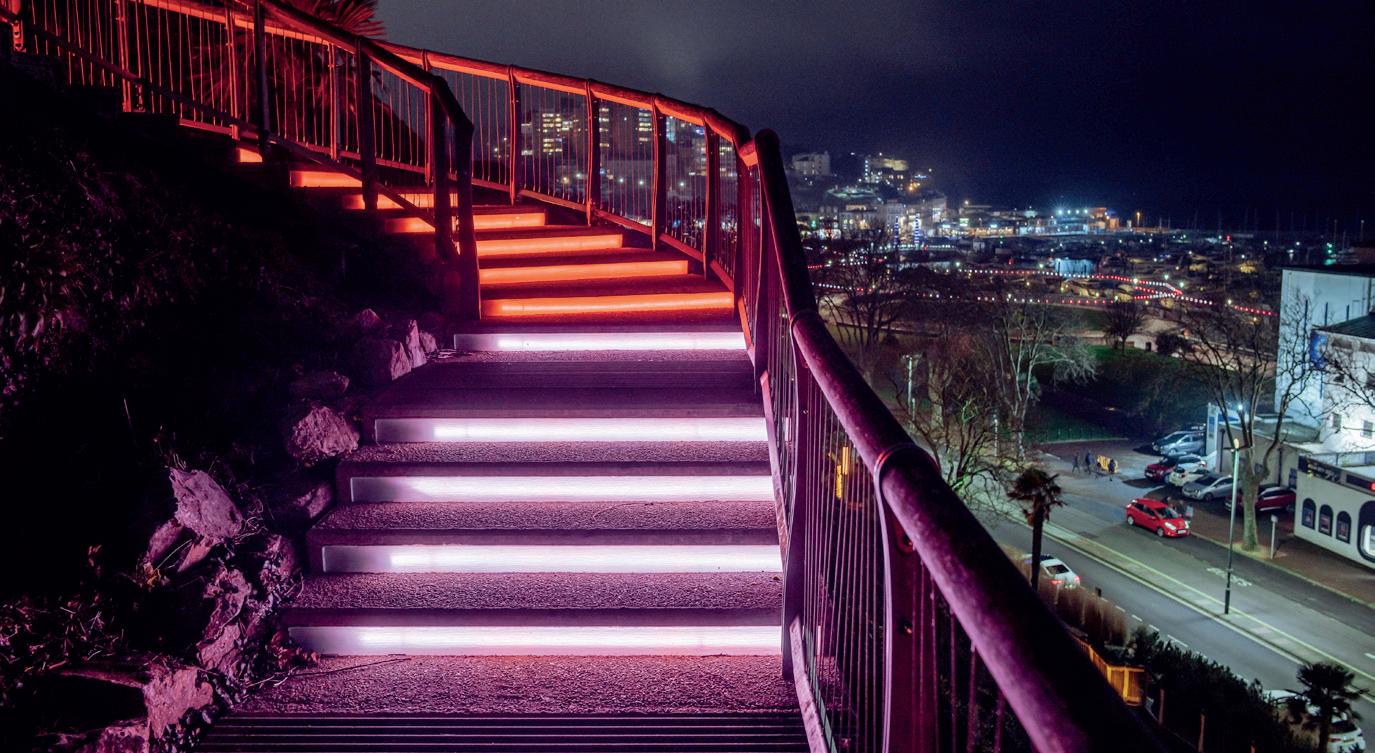

I’m quite a positive person and I think these are potentially very positive changes coming through; there is a real opportunity for lighting here. We have to embrace change, and that’s the same in any industry. It would be very boring if we just carried on doing the same old thing all the time.

We’re always going to need light. We are very lucky that the very core of what we do is a necessity to life, whether that’s artificial or natural. There is definitely going to be much more curation of darkness. I think having projects with darkness within them now resonates with people. So yes, I think lighting design is in a good place.
Lighting design
BRENT CROSS PROJECT
Michael Grubb Studio has created a sitewide lighting masterplan for the development of Brent Cross Town in north London, as part of a £5bn urban regeneration project bringing together 50 acres of green
space and playing fields, 7,000 new homes, retail, food, and drink venues, and three redeveloped schools, writesNicPaton
The studio is also working on six public realm projects within the area. These include Railway Street, High Street,
Claremont Way, Claremont Park, and Neighbourhood Square.
In addition, the practice’s team has recently completed designs for the new Brent Cross Primary Substation public artwork (as shown left).
The artwork, created by London artist Lakwena and architects IF_DO, features 21m-high painted steel girders, which surround the old electricity substation.

The aim has been to transform what up to now has been a neglected site, and what could be seen as a utilitarian structure, into an eye-catching landmark, in fact making it one of the largest pieces of public art in the UK.
As Michael Grubb has said of the project: ‘Brent Cross Town has been a significant project for us, which kept expanding from our original remit. It has been wonderful to start on a specific area of the town and keep growing our footprint into different areas, seeing the impact of our designs on so many of the area’s spaces and places.’
www.theilp.org.uk JUNE 2023 LIGHTING JOURNAL 25
Michael Grubb is founder and managing director of Michael Grubb Studio



JUNE 2023 LIGHTING JOURNAL 26
Architectural lighting
PUMP UP THE VOLUME
‘The Dubai Hills Mall branch gave us the opportunity to apply what we’d learnt in an entirely new context. It’s a much bigger site, so we were able to be quite imaginative with our design response and use different lighting techniques to create the visual features and mood transitions that they were looking for.
‘As you walk through the club, every aspect of the lighting has been designed to bring a sense of dynamism to the experience and personality to each individual scheme,’ she says.
By Nic Paton
FitnGlam is a chain of revolutionary (for the Middle East) women-only gyms located in Dubai. The brand’s mission is to create workout spaces that empower and inspire women but where they can also feel safe, motivated to work out yet at the same time calm and relaxed when in the wellness studios.
The brand’s latest ‘super club’, located in the Dubai Hills Mall, opened in the autumn of 2022 and features a lighting scheme by lighting design practice Nulty that is colourful, high contrast and fun as well as, of course, functional for the different spaces.
The practice worked with interior design and fit-out specialist INC Group and lighting solutions company Acoulite to design what is a multidimensional experience.
Lighting Journal spoke to Eline Maftoum, associate lighting designer at Nulty in Dubai, about the project.
‘We were brought onto the project by INC Group, who we had a relationship with because our teams had collaborated on a previous FitnGlam club,’ she explains.
DICHROIC FILM
Club members access the club from the mall and enter a reception area, where the lighting design helps to kick-start the transition from being in a retail mall to a more vibrant workout environment.
The interior design features strong colours and metallic finishes, with an eye-catching illuminated reception desk. Here, Nulty used a dichroic film along the length of the counter to produce a shimmering multi-coloured effect.
A gold mesh ceiling installation featuring crisscross lines of light forms a striking focal point overhead and maximises the impact of the bold use of light and materials.
To access the open gym and studios, members then walk through a dynamic light corridor designed to heighten the mood. The 360-degree tunnel alternates between energising hues of green, blue, and pink, and features vertical and horizontal lines of light that bounce off the reflective mirrored surfaces to create a mesmerising optical effect.
The interreflections here produce an endless repetition of light and colour to draw the eye and pull members through to their destination.
 The Nulty lighting scheme at the FitnGlam fitness studio in Dubai, here showing the ‘light corridor’
The Nulty lighting scheme at the FitnGlam fitness studio in Dubai, here showing the ‘light corridor’
www.theilp.org.uk JUNE 2023 LIGHTING JOURNAL 27
The lighting scheme for the new FitnGlam gym in the Dubai Hills Mall brings colour, high contrast and fun to this women’sonly workout space, helping to create a sense of transition through its different zones and an emotional connection to each distinct space
Architectural lighting
In the high-intensity areas of the club, dynamic lighting reinforces a stimulating and uplifting atmosphere in the open-plan gym area – and can be synchronised with music. Graphic linear profiles ramp up the ambience in the cardio area and were integrated within the metallic slates in a dropped ceiling for a clean, contemporary finish.
SWEEPING RIBBON OF LIGHT
Straight lines are juxtaposed with curves in the weights area, where a sweeping ribbon of light helps to both enliven the experience and emphasise the vast proportions of the space.
The individual workout zones are bordered by lengths of perforated gold panelling that have been backlit to graze light on to the textured surface and draw out the detail.
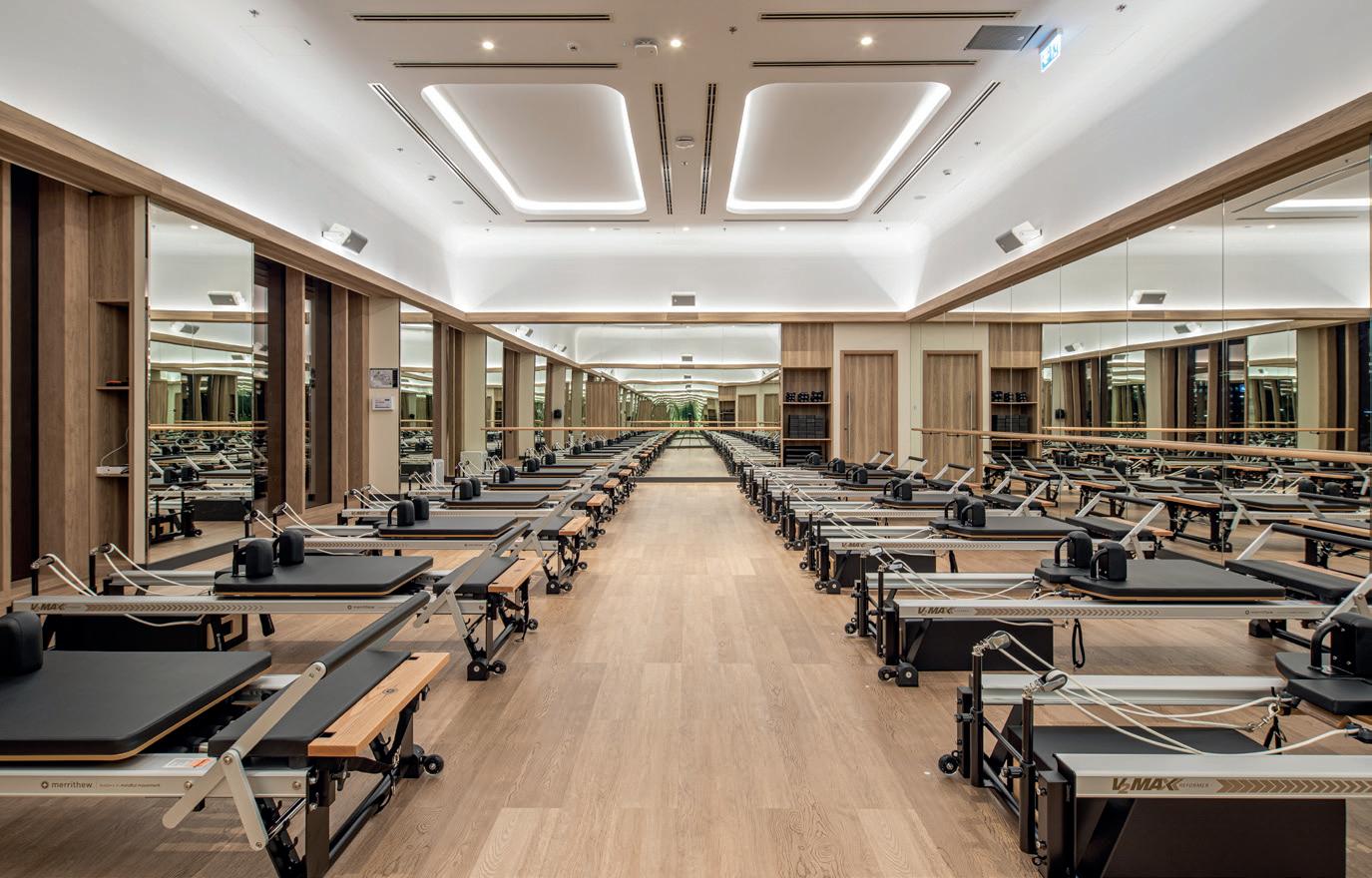

In the Mind & Body studios, by contrast, the intention here has been much more to create a sense of calm and harmony. In the Pilates studio, therefore, cove illumination and diffuse light around the mirrors contributes to a sense of simplicity of space.
A noticeable mood transition is also evident in the changing rooms, where neutral materials and iridescent pink hues are given space to breathe through indirect ambient light, which radiates from the ceiling and beneath vanity units.

Linear profiles graze each wall to accent lockers and changing areas, while integrated facial illumination around mirrors provides a warm, flattering glow of light on each vanity unit.
For Eline Maftoum, this sense of lighting working to enable transitions from and through very different spaces was another key to the design.
As she says: ‘One of the most important elements of the design is the journey from
JUNE 2023 LIGHTING JOURNAL www.theilp.org.uk 28
The weights and workout areas, where dynamic lighting creates a more stimulating environment. Below and overleaf: the more relaxing Mind & Body Studio and recreational spaces, where more diffuse light is used to create a sense of calm
MUSEUM OF SCIENCE AND INDUSTRY, MANCHESTER IN PERSON AND STREAMED LIVE ONLINE



CPD programme of relevant talks to solve your lighting problems. Develop your career with helpful workshops. Meet exhibitors who can help you. Free entry in person for local authority delegates









• • • • • T HE P OW ER T O M AK E LIGH T WORK THE PROFESSIONAL LIGHTING
SUMMIT
ILP PROFESSIONAL LIGHTING
MORE AND BOOK NOW, SCAN THE QR CODE
VISIT THEILP.ORG.UK/SUMMIT
YOU’RE INVITED TO THE
SUMMIT DISCOVER
OR
+ 15 JUNE
14
Architectural lighting
mall to fitness space, and then from gym to relaxation areas. Gyms are often transitional spaces where you arrive, workout and leave.
‘FitnGlam is different because the club environment is designed to be an embracing and immersive destination – members should feel compelled to linger. Because of this, lighting design helps to create different moods and a sense of belonging.

‘You can see this in the way that we used dynamic lighting in the cardio areas to get people’s pulses racing, then relaxed the aesthetic in the studios, cafes and changing rooms to take things down a notch and encourage people to relax and enjoy the space,’ Eline adds.
TRIAL AND ERROR
Drilling down into some of the different design elements, the dichroic film on the illuminated reception desk proved quite challenging to get right, Eline explains.
‘We experimented with samples and light sources beforehand to get a feel for the way that light interacts with the film. The same approach of playing around with light to read the aesthetics of the scheme was applied in the gym, where we illuminated a series of perforated metallic fins.
‘In this instance, we had to get a feel for the way that light bounced off the surface and hit the ceiling above – it was important here that we integrated the light with precision, to highlight the fins without exposing the mechanical elements above,’ she tells LightingJournal
Colour temperatures alternate throughout the different areas of the club, with RGBW and cool white LED lighting used in the high-intensity zones to create a consistent flow of energetic light, Eline highlights. By contrast, warmer light is
used in the Yoga and Pilates studios and café to soften the ambiance. ‘CRI was also important as the scheme is peppered with bold colourways, so we used a high CRI to make the materials and finishes pop,’ she says.
‘One of the key elements of the scheme was the showpiece light corridor, which is essentially our attempt to reinvent the traditional reception experience and heighten the sense of arrival,’ Eline continues.

‘It was designed to be completely immersive, so we experimented with colour, mirrors, and light to make the experience of walking from the reception to the gym a completely transformative moment.
‘The interreflections are deliberately mesmerising and produce an endless repetition of light and colour that pulls you through to your destination. We had to maintain a continuous flow of light through the tunnel to achieve a sleek,

seamless finish with no visible dark spots. It’s the most Instagrammable aspect of the space, so the execution had to be flawless,’ she adds.
The ribbon of light illuminating the weights area was also challenging to get right. ‘It was a complex element because the profile had to be sculpted to form a continuous sweep of light,’ Eline explains.
‘As technology moves so quickly, we’re used to seeing this kind of feature in projects now, but it was relatively new to the market when we specified it. We love it because it creates a real “wow” moment and brings a sense of intrigue to what is otherwise quite a minimalist space,’ she adds.
INTRINSIC TO THE EXPERIENCE
Finally, any learning points or takeaways from the project? ‘FitnGlam Dubai Hills is a good example of how lighting design can make all the difference. Often on a project, light is the unsung hero – the invisible element that influences how we emotionally connect to a space – but here the opposite is true,’ emphasises Eline.
‘Light is intrinsic to the experience and creates a visual impact from the moment you arrive. We were lucky to be working with a great interior design team who had a clear vision of what they wanted to achieve. It’s why the final scheme works so well because everything from the architecture and design, through to the lighting, acoustics and materials is working in harmony to make it a unique and memorable,’ she adds in conclusion.
PROJECT CREDITS:

Interior design and fit out: INC Group
Lighting design: Nulty
Lighting supplier: Acoulite
JUNE 2023 LIGHTING JOURNAL www.theilp.org.uk 30
Bee Seen CROSSAFE RETRO quickly upgrades a standard non illuminated 76mm Belisha beacon post into a fully illuminated post in less than 15 minutes.
Quickly converts a standard 76mm post into a 114mm illuminated post

No excavation or disconnection/ reconnection costs
High performance LED lighting

Adjustable daytime white band illumination brightness
Night-time dimming

IP 65 sealing to lighting elements


ZEBSTAR or ZEBSTAR+ beacon options

Reflective white bands
Aluminium construction
CROS SAFE RETRO ..be Safe



Requiring no ground works or re-cabling the down time to the crossing is kept to a minimum.
Adjustable daytime lighting makes sure the crossing is visible to drivers even in bright sunlight.
For more information

www.portlandtraffic.co.uk call us on 01922 666725 or email sales@portlandtraffic.co.uk Portland Traffic are a division of Portland Lighting and are part of the FW Thorpe PLC group of companies, working in partnership with TRT Lighting. ISO 45001


SPOTLIGHT ON HEALTH
Following the ILP and SLL’s evidence to the Lords Science and Technology Committee’s inquiry into light and noise pollution, three more leading figures from within the industry fed in important perspectives during April
 By Nic Paton
By Nic Paton
JUNE 2023 LIGHTING JOURNAL 34
Last month’s Lighting Journal (May) highlighted how the ILP and Society of Light and Lighting (SLL) came together in March to give combined evidence to the Lords Science and Technology Committee’s inquiry into light and noise pollution (‘Parliamentary scrutiny’, vol 88, no 5).


During April it was the turn of three other leading figures in the industry to give evidence to the peers: Colin Ball, lighting director at BDP; Arfon Davies, leader of lighting, UKIMEA at Arup; and Ian Ritchie, architect and founder of Ritchie*Studio.



For this session, where all three gave evidence remotely, the Lords focused on
the impacts of light, especially the effects of artificial lighting, in the context of health and wellbeing.
The evidence session opened with Conservative peer Lord Borwick asking the panel what factors around health did they feel should be considered when setting guidelines for lighting installations. In particular, what could be done to improve things such as sleep for patients in hospital, for example?


‘The first thing I would say, from the perspective of looking at guidelines, is that it’s important to recognise that daylight is really the light giver for the morning setting in particular. What we can do within artificial lighting is a fraction of what day-
Light pollution
light needs to do,’ said Colin Ball.

‘This can be of very strong, immediate impact in the morning period for a limited period of 30 minutes to under an hour. But the parallel to that, exactly as you say in hospitals, is the level of sleep disturbance that we have, not just within hospital rooms but within all sleeping environments, both internally and externally.
‘So, future guidelines should really be looking at setting maximum and minimum wavelengths at both night-time conditions as well as daytime. The tendency for guidelines at the moment is that they just state minimums. Even if they’re just recommendations, those minimums be met and over-exemplified and risk



www.theilp.org.uk JUNE 2023 LIGHTING JOURNAL 35
anolislighting.com UP CLOSE... FAR AWAY DIVINE™
Light pollution
assessed, so we’re on the whole as an industry over-shooting what are well-intentioned recommendations. But for daytime periods only,’ he added.
‘Health is a very broad subject, a very broad theme, and I think guidelines could really challenge people working with light in the built environment to consider both the physiological and the psychological impacts of lighting,’ said Arfon Davies.
‘We know that poor lighting and poor visual environments are shown to have negative psychological health impacts and physiological health impacts. So, I think not enough consideration is really given to the psychological impacts of light.
‘It is my view and that of many others in the lighting profession that we are setting unrealistic energy targets that, I think, draw focus away from where it should be. And that is creating lighting environments that promote health and wellbeing for people that occupy those environments,’ he added.

Ian Ritchie, meanwhile, pointed to our lack of knowledge currently when it comes to the impact of different lighting wavelengths on the mind, on our psyches. ‘I also think we don’t understand the value of darkness enough, and twilight. We talk about light but, actually, without darkness we don’t have any light,’ he said.
ROLE OF CIRCADIAN LIGHTING
Committee chair and crossbench peer Baroness Brown of Cambridge then asked Arfon Davies about the circadian lighting approaches used by Arup.


‘I think it is important to note that the science and the research is nowhere near complete. We don’t know enough about the visual and non-visual impacts of light on people. But our work does try to set out
what we think circadian lighting means and how we might approach that as a group of practitioners and designers,’ he replied.
‘We design for daylight first because this is essentially the human light. And then when we need to supplement that we do it in tune with daylight, we control it according to occupant comfort and variability. And we aim to produce lit environments that are visually interesting and stimulating,’ Arfon said, though adding that ‘it is an evolving subject.’
Just as the ILP and SLL panel had been asked in March, Liberal Democrat peer Lord Sharkey asked Colin, Arfon and Ian to rate how well they felt the UK was doing in terms of its policy response to tackling artificial lighting, on a scale of 1-10 (with one being the poorest).
All three of the panellists plumped for a relatively low score of three. Ian Ritchie highlighted how, in Hamburg 20 years ago, the authorities had switched down the
street lighting by half. ‘People were concerned there would be more accidents but, actually, what it reveals is that you get fewer accidents because people drive more carefully. They cycle more carefully; they cross the road more carefully. That was an interesting experiment which worked,’ he explained.
‘Then LEDs came along, and they pushed the lighting back up again to where it was. So I think there is a view one can take – and it relates to BS 5489 – which is to do with street lighting. It is a blanket approach, currently, rather than an intelligent, well-designed, thought-out approach. And that still avoids dealing directly with pavements, where people walk,’ he added.
‘There is a realm of unintended consequences where we can see, currently, that we get many more spaces with dark ceilings, with bright glaring fittings, but they are delivering a required lux under required efficiency,’ agreed Colin Ball.
JUNE 2023 LIGHTING JOURNAL www.theilp.org.uk 36
Arfon Davies giving evidence to the committee (with an image of Dawlish sea wall behind him). Below: committee chair Baroness Brown of Cambridge and, bottom, peer Lord Borwick
‘GOLD-STANDARD’ PROJECTS
During the evidence session, Lord Sharkey asked the panellists for examples of what they felt had been ‘gold-standard projects’ that had taken into consideration the health and environmental health impacts of lighting.
Ian Ritchie pointed to his practice’s work on the Sainsbury’s Wellcome Centre in Fitzrovia, central London.
The building’s innovations include a translucent glass envelope with a high thermal performance; light transmission levels keep lighting costs to a minimum while providing unparalleled diffused ‘white’ natural light. As Ian explained to the Lords: ‘It allows diffuse light into the space and that gives them about 300 lux at the back about 4m into the space. So it is a very nice environment.’
Flush with the façade are openable triple-glazed windows, with mechanically operated and adjustable cast glass louvres to suit each occupier’s requirements for privacy, clear views or to reflect afternoon sunlight deeper into the building.
‘It is also about having a quality of light
that you feel when you walk into the building in the morning,’ Ian added.
Arfon Davies highlighted Arup’s work on the sea wall at Dawlish, which was restored following the significant storm damage it suffered in 2014. The scheme, with lighting supplied by DW Windsor, includes 110 custom LED lighting modules installed along the walkway, set at an angle to wash across the pathway rather than illuminate
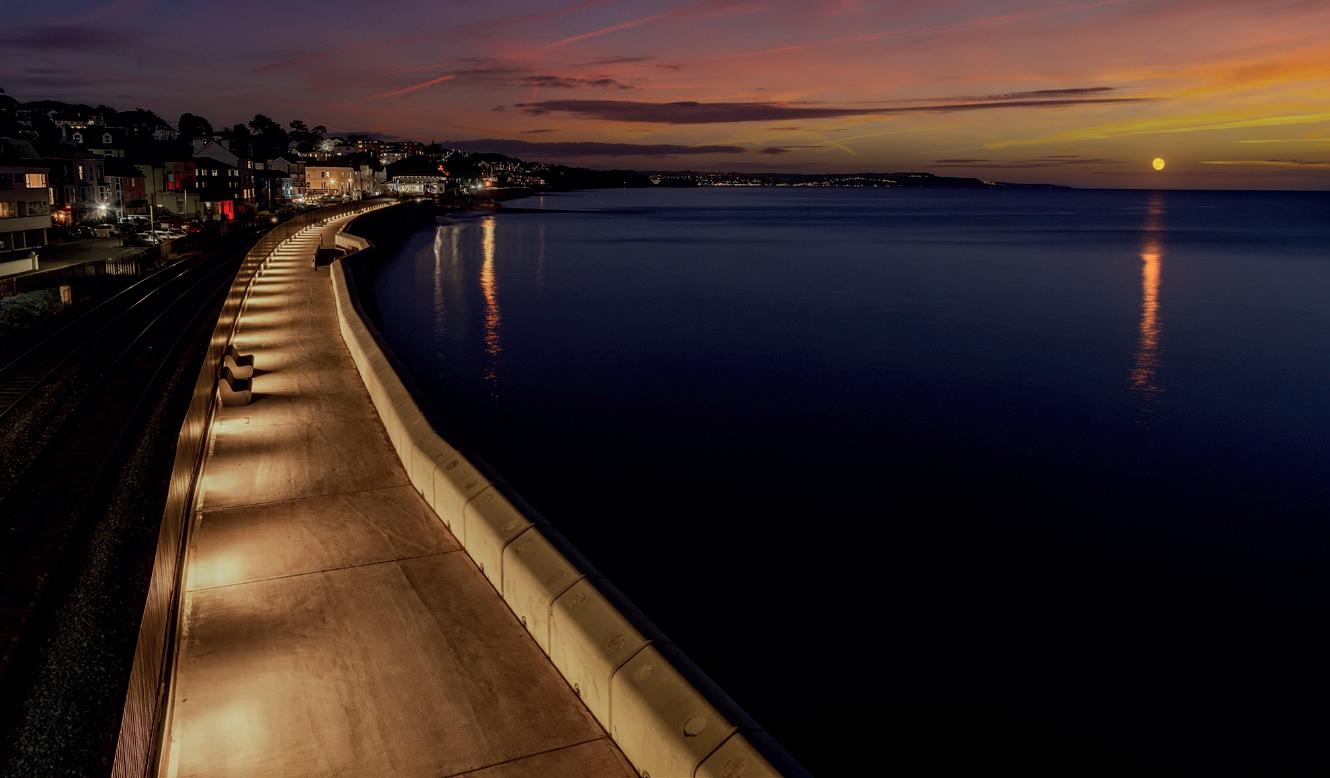
Light pollution
the space above it. ‘It creates a night-time environment that is limiting glare for train drivers; it creates a lit environment that is welcoming and safe for people,’ Arfon explained.
‘Previously, the occupants of Dawlish didn’t really use the promenade because it wasn’t lit safely. The new lit environment promotes people to be walking at night and that of course has a direct benefit to health and wellbeing.
‘The lighting design itself is very well co-ordinated and carefully designed so there is no light reaching the sky; all the light is contained within the new sea wall. It just generally creates a safe and welcoming environment because we used warm colour temperature lighting as opposed to what you typically see with road lighting is cool light. I think it meets this very interesting balance between lighting for place, lighting for people and lighting for planet in terms of limiting the impact on the environment,’ Arfon added.
Colin Ball chose BDP’s work on the University of East Anglia’s Enterprise Centre. ‘It has been officially declared the greenest building of the UK,’ he told the inquiry.

An exemplar of sustainable construction, the low-carbon building is designed to achieve a 100-year lifespan and exemplifies the use of low-embodied carbon materials. Timber, for example, came from Thetford Forest, straw for the innovative prefabricated thatch panels from Norfolk and various low-carbon building materials, including wood internal cladding, sonaspray ceiling treatments and flint were all locally sourced and fabricated.
‘We were able to apply a strict regime of lighting to the occupants and individuals and not waste light on empty space,’ Colin told the peers.

www.theilp.org.uk JUNE 2023 LIGHTING JOURNAL 37
The Sainsbury Wellcome Centre, showing its cast glass wall, with below Dawlish Sea Wall (image courtesy of DW Windsor) and, bottom, the UEA Enterprise Centre (photograph by Tom Niven)
Light pollution
Ian Ritchie giving evidence to the committee and, below, Colin Ball doing the same
‘We are in a realm where we have put layers of recommendations together and the quality of light has been dropping consistently for the last 15 years,’ he added.
Arfon Davies referred back to the 2009 Royal Commission on Environmental Pollution and its report ‘Artificial light in the environment’ [1]. ‘I think that’s still relevant but our knowledge and understanding of lighting as a discipline has moved on quite significantly since then.

‘And the Royal Commission report talks too much, I feel, about road lighting and focuses too much on rural and existing dark sky environments. I’m not suggesting these are not important but we should be considering the whole night-time environment. So that includes our towns and our cities.
‘But, to give a positive spin to the end of my answer, I am quite optimistic for the future. We’re currently reviewing the government’s proposed environmental outcomes reporting legislation, which is part of the Levelling-up and Regeneration Bill,

and I think that is very positive and will make a positive difference. It will compel developers, not just to assess the impact at the outset, but also to identify how these impacts will be monitored and, more importantly, validated post completion. That’s a very positive step forward I think,’ Arfon said.
Lord Sharkey then asked the panel: is there actual evidence to suggest glare is harmful, as opposed to just irritating?
‘I think there are indications it’s harmful. It is also not just irritating, it’s dangerous. If you take train drivers coming into London Bridge, the Shard between 8am and 10am, depending on the time of year, are blinded by the reflections off the Shard,’ agreed Ian Ritchie.
‘HEADLINE’ RECOMMENDATIONS

As the evidence session drew to a conclusion, crossbench peer Lord Rees of Ludlow asked the panel what they felt should be the ‘headline’ in any recommendations to government that come out of the inquiry.
‘I think there should be clear, clear guidance on external public space. And that I would probably define as urban, suburban and ex-urban,’ said Ian Ritchie.
‘I would point out that the Greenwich Observatory was used for observations of the Moon for the Moon landing, as late as the 1960s,’ said Colin Ball.
‘The issue of external light pollution has really only become an issue over the last few decades. So, it is easily correctable. And I think that lighting recommendations should really look at when and where lighting is powered, with an increased regime of efficiency and technology to make sure that we don’t have lamps burning in an empty space, internal or external, at 3am,’ he added.
‘I’d like to recommend that government considers how it can be more proactive and engaged in funding research, in partnership with industry,’ said Arfon Davies.
‘A great deal more needs to be understood about lighting and its impact on health and wellbeing, and I think the government has a role to play, in collaboration with industry,’ he added, in conclusion.
WHAT IS BEING INVESTIGATED
The Lords Science and Technology Committee announced in January it intended to conduct an inquiry into the impact of artificial light and noise on human health. The committee is seeking to understand three key points:
• the evidence base surrounding the impacts of artificial light and noise on human health in the UK;
• the nature of the current regulatory landscape for light and noise pollution and how well these regulations are enforced; and
• how policy should be adjusted to minimise the impacts of artificial light and noise on human health.
The oral evidence sessions were concluded during April and a final report is now expected to be published by the committee imminently.
The full evidence session is able to be viewed online here: https://www.parliamentlive.tv/Event/Index/ d610bd5f-f971-42cb-858a4b59d3a0b4f0
[1]
https://www.gov.uk/government/publications/artificial-light-in-the-environment JUNE 2023 LIGHTING JOURNAL www.theilp.org.uk 38
‘Artificial light in the environment’, Royal Commission on Environmental Pollution, 2009,

Obituary
‘THE STARS HAVE LOST ONE OF THEIR GREATEST FRIENDS’

Bob Mizon, one of the industry’s best-loved and most effective campaigners against light pollution, sadly passed away in April. Here, Steve Tonkin reflects on his contribution to dark skies

 By Steve Tonkin
By Steve Tonkin

‘FOR MILLENNIA, ON EVERY CLEAR NIGHT, HUMANS HAVE WONDERED AT THE AWEINSPIRING SPECTACLE OF THE STARRY HEAVENS… THE LIGHT FROM DISTANT STARS AND GALAXIES TAKES HUNDREDS, THOUSANDS, EVEN MILLIONS OF YEARS TO REACH US – WHAT A TRAGEDY TO LOSE IT IN THE LAST MILLISECOND OF ITS JOURNEY.’
It is with heavy hearts that we report the very sad news that Bob Mizon, whom many will know from his outstanding efforts to protect the night from the scourge of light pollution, died suddenly at home on 19 April.
For the last few decades, Bob has been the national co-ordinator of the British Astronomical Association’s Commission for Dark Skies (CfDS), which he helped to establish. But his astronomical interests ranged far wider than light pollution, as the many astronomical societies to whom he has given talks will attest.
Bob was born in Dagenham in London and was educated at East Ham Grammar School (London) and Adams Grammar School (Newport, Shropshire).
He became passionate about education and, after graduating from King’s College, London, where he read French and German, he had a 26-year career as a French teacher.
He satisfied his love of astronomy by running the school’s astronomy club, translating astronomy books from French, and
becoming an active member of the Wessex Astronomical Society.
AWARDS AND ACCOLADES
A major change came when, in 1996, he bought a mobile planetarium, which he named the Mizar Travelling Planetarium (Bob loved puns!), with which he took the wonders of dark night skies to nearly 150,000 children and adults all over Britain.
The International Dark-Sky Association awarded Bob its prestigious Galileo Award in 2006 and the David L Crawford Lifetime Achievement Award in 2016.

His work was formally recognised in the UK when he was awarded an MBE with the citation ‘For voluntary services to Astronomy and the Environment’ in the 2010 Queen’s Birthday Honours.
More recently, Bob was one of the instigators of the All-Party Parliamentary Group for Dark Skies, and was one of the people behind the establishment of the UK Dark Skies Partnership.
He was instrumental in helping
Cranborne Chase Area of Outstanding Natural Beauty (AONB) achieve its status as an International Dark Sky Reserve.
Early in 2023, ill health had caused Bob to cease his planetarium shows, but he continued to advocate for responsible outdoor lighting and represented the CfDS at the BAA’s ‘Winchester Weekend’ only the weekend before his death.

His friends knew Bob as a kind, gentle man, who was dedicated to his family. Decades before the term ‘rewilding’ entered common parlance, Bob had applied it to his garden, where he would enjoy the birds and insects that took advantage of this sanctuary that he had allowed to remain for them.
He leaves his wife, Pam, their three children, and a granddaughter... and the many of us who were privileged to have had our lives touched by his. The stars have lost one of their greatest friends on planet Earth.
Steve Tonkin is a dark sky adviser for Cranborne Chase AONB, Kerem Asfurogla is creative director at Dark Source
Illustrated by Kerem Asfuroglu
JUNE 2023 LIGHTING JOURNAL 40
The Safety of Lighting
Lighting has a profound and often misunderstood effect on all aspects of the human experience.
Did you know well-designed and implemented lighting can be used to detect criminals? For example, sensors can be attached to lights, which can pinpoint the location of criminal activity and send a signal to the emergency services quicker than anyone would be able to phone, allowing a faster response to rescue.
Introba can be your partner in specialist design and assessment of light and lighting in all environments including:

Urban Realm, Interior and Exterior Lighting

Highway and Transportation
Landscape and Heritage
Aviation, Maritime and Border Facilities
Architectural and Feature Lighting
Sports Lighting
Planning Support
Daylight Analysis and Design
Obtrusive Lighting and Environmental Baseline Studies
Photometric and Performance Measurement
GN22 Asset Condition Assessments
Expert Advice and support
For further information on how Introba can help you, contact Lighting Design Consultant Kimberly Bartlett.
E: kimberly.bartlett@introba.com
T: 0203 697 9300
 ©Martin Knowles Photography
©Martin Knowles Photography
‘OPEN’ TO INNOVATION

The use of open-neutral fault detection technology could accelerate electric vehicle charging infrastructure, providing social, economic and environmental benefits, argues James
By James Barker
Barker
JUNE 2023 LIGHTING JOURNAL 42
Electric vehicle (EV) adoption is rapidly increasing across the globe, driven by government targets for a net-zero carbon economy.
The UK has set its target of net zero by 2050, with a significant proportion of this target reliant on the uptake of electric transport, and a steep acceleration curve between the time of writing and 2030.
While the government has put in place a range of incentives to encourage EV uptake, the EV charging infrastructure remains a significant challenge. One innovation that could help us address this challenge is innovative ‘open-neutral’ fault detection technology.

The technology seeks to solve a fundamental problem, inherent with the UK’s most common earthing system in the electricity distribution networks.
The protective earthed neutral (PEN) conductor, used in the protective multiple earthing (PME) system, is used for combined neutral and earthing functions.
A main earth terminal (MET) is provided at the consumer’s installation, which is derived directly from the PEN conductor. If the PEN conductor fails, in the form of an open circuit within the distribution network, it can lead to an electric shock when any metallic parts such as street furniture. This can include when any bonded metalwork in the highway is
Electric vehicle charging
touched by a person, who is in simultaneous contact with the general mass of Earth.
Unfortunately, previously existing methods of electrical protection, such as common circuit breakers (CBs) and residual current devices (RCDs), cannot detect this type of fault and therefore cannot offer any protection to preserve life in these instances.
As a consequence of the issues described with the PME system widely utilised in the UK, the IET Wiring Regulations BS:7671 2018 Amendment 2: 2022, Regulation 722.411.4.1, states that [1]: ‘A PME earthing facility shall not be used as the means of earthing for the protective conductor contact of a charging point located outdoors, or that might reasonably be expected to be used to charge a vehicle located outdoors, unless one of the following methods is used:
1. The MET of the installation is connected to an installation earth electrode by a protective conductor. The resistance of the earth electrode to Earth shall be such that the maximum voltage between the main earthing terminal of the installation and Earth, in the event of an open-circuit fault in the PEN conductor of the low voltage network supplying the installation does not exceed 70 Volts rms.
2. Protection against electric shock is provided by a device which electrically disconnects the vehicle from the live conductors of the supply and from protective earth within 5 seconds, in the event of the voltage between the circuit protective conductor and Earth exceeding 70 Volts rms due to an open-circuit fault in the PEN conductor of the low voltage network. The device need not operate if the voltage exceeds 70 Volts rms for less than 4 seconds. The device shall provide isolation. Closing or resetting of the device shall be possible only if the voltage between the circuit protective conductor and Earth does not exceed 70 Volts rms.
3. Protection against electric shock is provided by a device which electrically disconnects the vehicle from the live conductors of the supply and from protective earth within 5 seconds, in the event of the utilisation voltage at the charging point, between the line and neutral conductors, being greater than 253 Volts rms or less than 207 Volts rms. The device shall provide isolation. Closing or resetting of the device shall be possible only if the voltage between line and neutral conductors is in the range 207 to 253 Volts rms.
www.theilp.org.uk JUNE 2023 LIGHTING JOURNAL 43
Electric vehicle charging
4. Protection against electric shock is provided by the use of an alternative device to those in (ii) or (iii) which does not result in a lesser degree of safety than using (ii) or (iii). The device (or means of functionality) shall operate by electrically disconnecting the vehicle from the live conductors of the supply and from protective earth and also provide isolation.’
So, what does all this mean? Essentially, without innovation providing suitable technology to address the requirements set out in items 1-4 above, then item one is the only existing method of achieving a suitably compliant earthing arrangement. However, the installation would require its own independent earth connection by way of a buried earth electrode at or near to the source of the supply. So, what are the associated problems with this?
OPPORTUNITY FOR RETROFITTING
First let’s take a brief look at the opportunities we have and consequently ‘what we could be leaving on the table’ if innovation is obstructed or ignored, thus impeding the uptake of early adopters and resulting in a slow diffusion process.
Making use of existing street lighting infrastructure for EV charging is becoming an ever-more appealing option, using equipment which can be retrofit to lighting columns.
It would seem like a simple and logical approach for local authorities to quickly engage with charge-point operators (CPOs) and demonstrate their commitments to solving the increasing need for public electric vehicle charging point (EVCP) infrastructure.

It is also, in theory, a useful solution for the roll out of slow chargers for electric vehicles for several reasons. These might include:
• Using existing street lighting supplies can be a cost-effective solution for providing power to slow chargers. It eliminates the need for expensive new electrical infrastructure to be installed, which can save a significant amount of money.
• Street lighting supplies are already available in many areas, and therefore, using the spare capacity in the supplies for EVCPs can increase the availability of charging infrastructure without the need for additional infrastructure investments.
• Street lighting supplies are often located in convenient locations, such as parking lots and on-street parking
spaces, making them easily accessible to EV drivers.
• Reusing existing street lighting supplies for EV charging can contribute to a more sustainable future by reducing the need for new electrical infrastructure and promoting the use of clean energy for transportation.
It is easy to see the opportunities that could be missed if we do not take advantage of existing infrastructure. So, what is holding us back?
PROBLEMS AND BARRIERS
This is where industry has identified problems and barriers, which relate to the feasibility of installation and technical conformance.
Retrospectively installing earth electrodes at existing street lighting columns in the highway presents a range of problems, disadvantages and challenges. These include the following examples:
• The installation of earth electrodes and associated equipment can be costly, especially if it involves significant excavation work to install earth grids and/or rods.
• The quality of the ground can disrupt the effectiveness of the earth electrodes, often exacerbated during seasonal changes. If the ground is dry or rocky, it may be difficult to install earth electrodes that will provide a suitable earth connection.
• Maintenance of the earth electrodes
and associated equipment can be time-consuming and expensive. The electrodes may need to be periodically checked and replaced if they become damaged or corroded.
• Installation and maintenance work can cause disruption to traffic and pedestrians, particularly if the work involves excavation in the street.
• There may be technical challenges involved in the installation of earth electrodes, such as ensuring that the connection to the earth is of a sufficiently low impedance and that the electrode is properly bonded to the electrical system.
• The installation of TT earthing requires certification by a competent person, which can add to the overall cost and complexity of the installation.
• Coordinating with the relevant authorities, such as the local council, to carry out the work and obtain the necessary permits and approvals can be time-consuming and complex.
There is also a range of technical challenges in respect of the overall integrity of a TT earthing system and the effects it may have on other systems and equipment, or inadvertently be subjected to itself.
TT installations for charging infrastructure, derived from PME supplies, may not ultimately always be the safest option. This could be due to simultaneous contact issues between two different exposed-conductive parts on different earthing systems, along with the risks associated with
JUNE 2023 LIGHTING JOURNAL www.theilp.org.uk 44
Electric vehicle charging
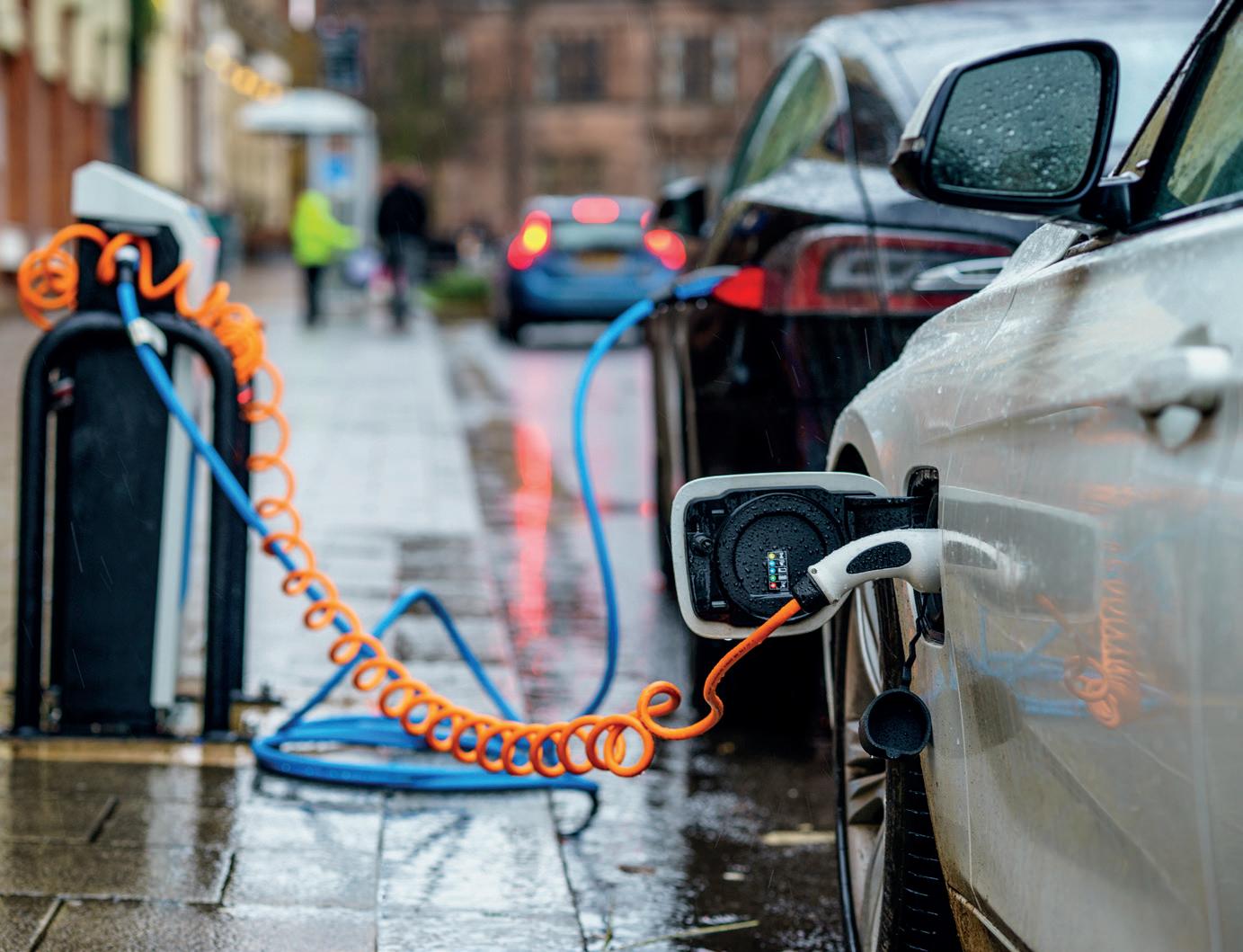
interactions between earthing zones of a local PME system and the TT earth electrode provided for the charging point(s).
RISK ASSESSMENT
Before a TT system is installed, a risk assessment should be carried out so that risks of simultaneous contact with electrical installations, including other street furniture with PME earthing, are minimised. This is generally only acceptable if all of the following conditions apply:
1. There is no possibility of simultaneous contact between exposed and/or extraneous-conductive parts of the TT earthing system and exposed and/or extraneous-conductive parts of the PME (TN-C-S) earthing system of the main installation, or any other earthing system of a nearby installation.

2. The earth electrode zone of the TT system must not overlap the zone of any buried metalwork connected to the earthing system of the main installation. If it does, the benefit of separating the earthing system will be lost.
3. Buried metalwork connected to the PME system does not unduly influence the potential of the ground on which someone will be standing, adjacent to the vehicle, in the event of a fault in the supply PEN conductor.
It is often forgotten (or perhaps not known) that buried metalwork connected to the PME system can, in fact, include the low voltage distribution network itself. This is where historic cable types such as paper insulated lead covered (PILC) cables have a metallic sheath (or armour) in direct contact with the mass of earth.
The resistance of an installed earth electrode should not normally exceed a specific low Ohm value, usually being 200 Ohms at most. This might be achievable upon installation, but this low resistance value needs to be maintained, ensuring the integrity of the installation throughout its lifetime.
Maintenance could require a repeat need for excavation and repair or replacement of the electrode and earthing conductor, creating further inconvenience, risk and cost.
Overall, whilst reconfiguring the supply from PME to TT satisfies item one of Regulation 722.411.4.1, BS:7671 2018 Amendment 2: 2022, the installation of earth electrodes at existing street lighting columns in the highway can be costly, technically challenging, and disruptive, whilst
also requiring ongoing maintenance and certification [2]
What would embracing open-neutral fault detection technology offer? Here are some thoughts and views on this matter.
One of the key advantages of open-neutral fault detection technology is that it removes the need to convert the existing unmetered supply from PME to TT and subsequently install earth electrodes at each streetlight.
Consequently, it could considerably reduce installation costs, along with reduced need for street works and the associated inconvenience and disruption that comes with it.
Importantly, it eliminates risks associated with driving earth electrodes into the ground or the need for excavation. It also overcomes the issues in finding adequate space to install earth electrodes in our busy footways, taken up by the abundance of utilities and services that our modern needs rely on.
Enabling EVCPs to be mounted directly on to existing structures, such as street lighting columns, could support a faster roll out of charging infrastructure and thus the contribution to meeting 2030 and beyond targets, as per the government’s manifesto for net zero.
www.theilp.org.uk JUNE 2023 LIGHTING JOURNAL 45
An open-neutral device. Greater use of such devices could reduce installation costs and accelerate the rollout of community EV charging, argues James Barker
Electric vehicle charging
SOCIO-ECONOMIC BENEFITS
In addition to reducing the cost and complexity of installation, open-neutral fault detection technology offers a socioeconomic contribution.
It standardises installation, enabling communities to benefit from accelerated EV charging infrastructure. It minimises or eliminates civil works, so reducing the risks associated with excavation in the highway and the inconvenience caused to the public.

It could help to provide a more reliable and consistently low earth fault loop impedance (EFLI) all year round, further reducing the risk of electric shock and enhancing public safety.
Some might suggest that it is essential for the EVCP stakeholders to embrace the opportunity to be early adopters of this technology, and not to be seen as laggards, articulated in the diffusion of innovation model once described by Everett Rogers in 1962.
While invariably some stakeholders might have reservations associated with the new technology, particularly as specific product standards do not yet exist, this is understandable during the early and potentially most risk-saturated stage of innovation diffusion.
However, relevant regulations and
guidance such as, BS:7671 IETWiringRegulations, Code of Practice for Electric Vehicle Charging Equipment Installation, and the Energy Networks Association’s Engineering Recommendation G12 do exist, all of which consist of technical panels, working groups and credible industry experts and stakeholders [2]
Decisions to embrace a technological innovation such as open-neutral fault detection equipment can be reliably informed with reference to these sources and should help to provide confidence and structure when assessing the suitability and justification for adoption of new technology and related products.
SUMMARY OF ADVANTAGES
We may wish to ask ourselves: what could be considered a realistic and objective summary of benefits for adopting open-neutral fault detection technology to protect against open-circuit PEN faults?
Here are some points to get you started. It standardises installation and minimises or eliminates civil works, so reducing risks associated with excavation in the highway and the inconvenience caused to the public.
It eliminates excavation risks associated with installing earth electrodes. It






overcomes the issue of inadequate space for earth electrodes in footways.
It enables EVCPs to be mounted directly on to existing highway structures, such as street lighting columns. It provides a more reliable and consistently lower earth fault loop impedance (EFLI) throughout the year, regardless of seasonal changes affecting the local ground/soil conditions. It enhances the contribution to sustainability of existing electrical infrastructure.
Needless to say, it is manufacturers of electrical equipment that contains open-neutral fault detection technology who should be responsible for making available adequate information.

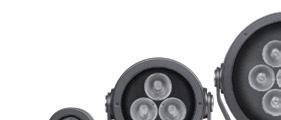
This, in turn, will provide designers and installers with the confidence needed that their product satisfies the requirements of regulations and engineering recommendations.
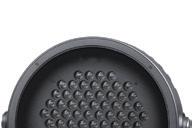

This is particularly important during the absence of product standards. Equally, designers and installers of such equipment should recognise their obligation to undertake these checks on the suitability of a particular product, or otherwise seek professional advice.




It is reasonable to expect that other key stakeholders such as distribution network operators (DNOs) may also wish to investigate the effects or adequacy of the technology or a particular product’s influence on their network.
So, finally, should we be paying more attention to our options and accelerating the exploration of technological solutions, solutions that potentially solve complex problems and create better opportunity? It would certainly seem logical to assume so. Is this not just part of the natural innovation process?
It is entirely normal and correct, in fact, to be mindful of the potential impacts of a technological innovation. But should we let that slow us down in determining if it could make a positive difference?
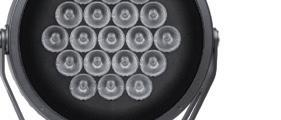
Ultimately, an ethical approach to the use of a new technology should always be adopted. However, failure to move at all will inevitably inhibit progression, at a time when demand for infrastructure is high and resource pools across a range of skill-sets are stretched.
Wiring Matters, The IET, No 83, November 2020, https://electrical.theiet.org/wiring-matters/years/2020/83-november-2020/the-impact-of-amendment-2-of-the-18th-edition-bs-76712018plusa22022/


[2] BS:7671 IET Wiring Regulations, Code of Practice for Electric Vehicle Charging Equipment Installation, and the Energy Networks Association’s Engineering Recommendation G12, The IET, https://shop.theiet.org/code-of-practice-for-electric-vehicle-charging-equipment-installation-4th-edition; Engineering Recommendation G12 Issue 4 Amendment 2, 2021, ENEA, https://www.dcode.org.uk/assets/uploads/ENA_ER_G12_Issue_4_Amendment_2__2022_.pdf
 [1] ‘The impact of Amendment 2 of the 18th edition (BS 7671:2018+A2:2022)’,
[1] ‘The impact of Amendment 2 of the 18th edition (BS 7671:2018+A2:2022)’,
JUNE 2023 LIGHTING JOURNAL www.theilp.org.uk 46
James Barker is technical director at Electrical Testing Ltd
anolislighting.com CALUMMA™ OUR NEW FAMILY






FAMILY FORTUNES
As well as enjoying CPD and networking, let’s use this this month’s Professional Lighting Summit to celebrate the longstanding relationship between the ILP and its lighting manufacturer ‘family’, argues CU Phosco’s Matt Murray
By Matt Murray
We’re all looking forward to gathering in Manchester later this month for this year’s ILP Professional Lighting Summit (PLS). It promises to be, once again, a great two days of CPD, networking, and catching up with old friends and colleagues. And, from our perspective as a lighting manufacturer, the Summit is always a valuable opportunity to showcase our products and how we support the industry.
For me, however, the fact we’re exhibiting again at the PLS is about much more than the commercial or transactional benefits that might come from that. Like many lighting manufacturers, we have a rich, deep and very longstanding relationship with the Institution.
This year is CU Phosco’s 100th anniversary and so I’ll also be using the Summit as an opportunity to reflect on and celebrate not only on our own hundred years but the relationship CU Phosco has had with the ILP (and its previous iterations) in that time.
In fact, our relationship with the ILP goes right the way back to our beginnings (although of course the ILP was at that point the Association of Public Lighting Engineers).

David Lodge, our former technical director who is now moving on to become an independent consultant, is heavily involved in the ILP’s technical work, sits on Technical Committee and works closely with the ILP team, led by Technical Manager Guy Harding, on its pipeline of technical publications.
His predecessor, Clive Lane, was also closely involved in the ILP for many decades (the ILE as it then was), both on the technical side and as a regional presence. He was even one of the few people to have been ILE President on more than one occasion. Before the ILP switched to the current LDC structure, I, too, was chair of the Western Region for a good few years.
‘SAVING’ THE INSTITUTION
Going back still further, our Charles Marques Memorial Lectures were an important part of the ILP calendar for many years, from the 1970s onwards. Robin Marques, our former chairman, was even credited by former chief executive Richard Frost as being ‘the man who saved the Institution’.
For those unaware, as Richard wrote on Robin’s passing in 2014, back in the late 1970s, the APLE was headquartered in a basement office in Buckingham Gate, London, and was in rather a parlous financial state (‘The man who save the Institution’, Lighting Journal, October 2014, vol 79 no 9). There were even tales from that time of
JUNE 2023 LIGHTING JOURNAL 48
the President’s badge having been hollowed out to make it easier to wear – but the precious metal taken out then disappearing!
Robin, as new honorary treasurer, took it upon himself to mount a rescue plan, relocated the Institution to Rugby (to Lennox House), appointed a new secretary and brought in some new members of staff (including Chantal O’Sullivan, who many ILP members will of course still remember). From the sale of the Buckingham Gate premises, he also made a series of shrewd investments that helped put the Institution back on to a firmer financial footing.
RUGBY MUSEUM
Over our 100-year history, many people have donated lighting ‘kit’ to us, in fact we have our own lighting column museum at our facility in Ware, including columns that go back to the 1940s and 1950s. It also contains our very first sales brochure, from 1926.


But, as well as our own museum, we’ve over the years donated various items to the ILP’s lighting museum in Rugby. Given how things have been since the pandemic, that may not be physically visited that often these days by ILP members, but it is still an important and valuable resource of lighting history.


So, what am I saying here? I’m trying to make the point that, often, lighting manufacturers are thought of as simply supporters of the Institution, there ‘for’ the membership, whether that be engineers, designers, specifiers, consultants or others.
And, to an extent, we are of course. Our products and expertise enable lighting professionals to function and do their jobs brilliantly. But – and I think this time of the year, with the PLS looming, is a great time to state this – lighting manufacturers, especially the most longstanding ones, also are the Institution.

We are custodians of lighting’s heritage and history – literally in the case of our museum and the ILP museum – but also custodians of the history and institutional memory of the Institution itself.
So, when you’re in Manchester, yes please of course do check out our exhibition stand, talk to us about our products and wish us a happy 100th birthday. But let’s also take a moment – perhaps raise a glass – to recognise and celebrate the relationship and history, the unbreakable bond, that also exists between the Institution and its lighting manufacturer ‘family’.
www.theilp.org.uk JUNE 2023 LIGHTING JOURNAL 49 Inside the ILP
Matt Murray is sales director at CU Phosco
LET’S GET TALKING
The ILP’s ‘Strategy 2026’ five-year roadmap will be a key talking point at the Professional Lighting Summit later this month. ILP Chief Executive Justin Blades outlines progress so far and how members can help
By Justin Blades
JUNE 2023 LIGHTING JOURNAL 50
Back at the beginning of the year, I outlined in these pages how the ILP’s ‘Strategy 2026’ five-year roadmap was developing and evolving (‘Lookingto thefuture’, vol 88, no 1).
As we look forward to the Professional Lighting Summit (PLS) later this month –which is of course very much the half-way point of the ILP year and the CPD highlight of our calendar – it is a good moment to reflect on the progress that has been made since then.

To recap, the strategy is designed to set out our path, our ‘roadmap’, to 2026. It articulates that the ILP as an Institution will focus on six core values, namely being: professional, ethical, honest, open, accountable, and innovative.
On top of this, the strategy has set out five strategic aims that will underpin the development and delivery of services for members going forward. These are:
• Aim 1. To be respected for our professionalism and competence in lighting.
• Aim 2. To be trusted as a source of technical information on lighting by supporting and enabling a diverse group of practitioners.
• Aim 3. To deliver value, information and services to members and the professional lighting community 24/7 365 days a year, regardless of location, using digital platforms.
• Aim 4. To secure the future of the lighting profession by encouraging the next generation of lighting professionals to join the industry – and equip them with the skills and knowledge to succeed.
• Aim 5. To ensure that legislation, technical standards, and other legal instruments that affect lighting have best practice as their foundation.
During the past six months a lot of work has gone on behind the scenes to flesh out how these five aims can evolve from aspiration to reality.
As part of this work, we’ve developed and are taking forward five core strategy change projects. These are looking at:
• membership development;
• our technical knowledge base;
• pathways into lighting;
• our industry partner recognition scheme; and
• external stakeholder engagement.
We’ve recently held our first project team meeting on the membership development strand of work, which went very well and from which a project outline has now been developed.
The next stage for this will be to hear, listen and evaluate what members feel a ‘good’ lighting professional needs to look like in terms of skills, experience and qualifications.
Is it still important, for example, that Engineering Council registration remains the foundation of the lighting professional’s skills and experience? Or, with the industry changing so quickly, is there an argument for greater flexibility and even divergence?
WHAT SHOULD ‘GOOD’ LOOK LIKE?
Within the technical knowledge base strand of work, this, self-evidently, overlaps closely with membership development. The focus here, again, is what does ‘good’ look like, and need to look like, in terms of professional skills, skills and expertise?
What do, and will, lighting professionals need in terms of foundation skills at the beginning of their career? What, too, do and will they need right the way through to becoming an advanced, senior professional in our industry? What needs to be, or become, the technical ‘ladder’ of competence throughout a lighting professional’s career? What, too, does ongoing CPD need to look and feel like alongside this?
Our ‘pathways into lighting’ strand of work is about working to build and embed the building blocks of that technical knowledge base. So, it is about articulating the qualifications, competencies, technical, CPD and specialist knowledge base that a ‘good’ lighting professional will need – but also the routes they will be able to follow to achieve this level of professional excellence.
At a practical level here, there have already been some constructive meetings between the ILP and Ayça Donaghy, the new chief executive of the Lighting Industry Association, who is very keen to work with us on taking this agenda forward. Equally, we have been deepening our engagement and collaboration with the Highway Electrical Association (HEA), with myself and HEA chief executive Michael Levack now working together increasingly closely. So, as I say, there is a lot of work going on, albeit it much of it, for now, in the background.
The ILP team, spearheaded by myself and Technical Manager Guy Harding, has been working hard with our close-knit volunteer
team, with current ILP President Fiona Horgan and Senior Vice President (and incoming President) Rebecca Hatch doing amazing work, among others.
BRINGING FORWARD THE MEMBER VOICE
With much of the foundational work now complete, what we’re going to be focusing on going forward, over the next six months, is working to bring your voice – the member voice – more clearly into focus in all these streams of activity.
I said it back in January, but the message is therefore very much the same: your Institution needs you!
Please come forward and make sure your voice is heard. If you feel you have the experience and expertise or knowledge to feed in or contribute to these strands of work, then, please, the ILP is all ears.
We will be in the coming weeks and months looking to populate various project teams, with an aim to really beginning to accelerate activity and progress.
We are keen to be in a position that by next year, 2024 – our centenary year of course –we are well on the right track, the right path, to delivering practical, tangible change.
What we want to see emerging over the next weeks and months is a membership offer, a technical knowledge base, new pathways into industry, new partnerships, and new external stakeholder engagement models that can really make a difference.
But we’re going to need your help to achieve this. Let’s use both the PLS in Manchester and a summer and autumn of connection, engagement and conversation to kickstart this exciting change process. I look forward to hearing from you.
Justin Blades is Chief Executive of the ILP
GET INVOLVED
To discuss the strategy, find out more or get involved, please contact Justin Blades on justin@theilp.org.uk
You can find ‘Supportinglightingprofessionalsforthebenefitofsociety:InstitutionofLightingProfessionalsStrategy 2026’ at https://theilp.org.uk/ strategy2026/
www.theilp.org.uk JUNE 2023 LIGHTING JOURNAL 51 Inside the ILP
The 2023 Professional Lighting Summit
MANCHESTER MATTERS
With the speaker line-up confirmed and delegate booking now open, don’t delay in signing up for what promises to be a Professional Lighting Summit to remember from 14-15 June. Jess Gallacher and Guy Harding outline what you can expect
By Jess Gallacher and Guy Harding
Whether your interest is the impact of light on crime, lighting’s role in our race to net zero, controlling light in public spaces, or what comes after PFI, this month’s Professional Lighting Summit (PLS) in Manchester has something for you – and that’s just a taste of what’s going to be a jam-packed two days of CPD, networking and showcasing.
To recap, this year’s PLS is being held from 14-15 June at Manchester’s Science and Industry Museum.

The speaker line-up has now been finalised and the Summit is open for delegate booking – full details are at the end of this article. So, what can you expect?
The two days of CPD will kick off with UCL’s Professor Peter Raynham looking at the hugely topical issue of the impact of light and dark on crime in London.
In what promises to be a fascinating paper, Peter will discuss the relationship between lighting and crime, based on a study of Metropolitan Police crime records, and how changes between night and day (and within that the use of artificial light) can affect crime rates.
Nick Griffin from WSP and London Borough of Southwark’s Perry Hazell will consider lighting and net zero. Nick will look in detail at the ambitious – and massive –LED upgrade programme being rolled out in England by National Highways.
Perry, in turn, will have a more local focus, discussing his borough’s ‘journey’ to net zero, in particular its rollout of electric vehicle (EV) charging infrastructure, introducing an EV maintenance fleet, deport upgrades and the use of solar lighting.
BEYOND ‘THE RED LINE’
Jo Harding, presenting for manufacturer Anolis, will look at latest guidance and best practice around façade lighting, and Luciana Martinez, from Light Follows Behaviour, will consider ‘the red line’ (or project scope line) within lighting design.
Luciana will address how the fact light does not respect the conventional red lines of a project in the same way as do, say, paving, planting or buildings makes it even more imperative that teams work collaboratively and across disciplines to deliver successful projects.
Alan Grant of DW Windsor will present on the latest trends in exterior lighting, in particular the challenges associated with dark sky lighting, evolving smart technologies, the reduction of waste, and sustainability.
JUNE 2023 LIGHTING JOURNAL www.theilp.org.uk 52
WE GET TECHNICAL BECAUSE WE CAN


Our NERS scopes enable us to carry out all LV Design, Jointing Craft, Civils and Cable Laying activities.

www.electricaltesting.co.uk
The 2023 Professional Lighting Summit
‘HOUSE OF HARDING’
One event not to be missed will be our ‘House of Harding’ panel discussion, led by Guy Harding, and which will bring together the LIA’s Bob Bohannon, Allan Howard of WSP, the SLL’s Andrew Bissell and Jacobs’ Stuart Morton.
Between, more widely, simply putting the world of lighting to rights, they will discuss the Department for Energy Security and Net Zero/Department for Business, Energy and Industrial Strategy proposed limitations on LED efficiency.
The panel will also reflect on the value of the industry ‘speaking truth to power’ with one combined voice, as was recently seen in Guy, Allan, Andrew and Stuart coming together to give evidence on light pollution to the Lords Science and Technology Committee (‘ Parliamentary inquiry’, May 2023, vol 88, no 5).
The use of lighting controls within the built environment will be considered by both Alan Jackson of Helvar and Emily Bolt of Signify. Alan will look at how controls can be better used to drive environmental benefits, while Emily will address the role of controls in our public spaces of the future.
Building on his article in the April edition of Lighting Journal (‘Casting a spell’, vol 88 no 4), Andy Statham of Cast Iron Welding Services will delve into the detail of how to repair cast-iron columns and, importantly, how to embed a circular economy ethos and approach into this.

David Lodge, formerly of CU Phosco and now an independent consultant, will look at PAS 190:2023 Existing lighting and CCTV columns – Assessment for multi-functional use – Code of practice and PAS 191:2023 Multifunctional
columns. Design. Specification. In particular, he will discuss what columns can be used for and their limitations as we increasingly think beyond the ‘humble’ lamppost.
Amanda Reece of DFL will then delve back into the archives to look at women lighting pioneers, including lesser-known female lighting, electrical and engineering luminaries. How, she will ask, can inventors of the past inspire us to innovate for the future?
Finally, two former ILP Presidents –Elizabeth Thomas and Anthony Smith –will get out their crystal balls to consider the past, present and, critically, the future of PFI, the private finance initiative.
Anthony will outline how, on the one hand, PFI funding has kickstarted unprecedented investment in highway and amenity lighting. However, on the other, he will argue that it has created a landscape of maintenance and asset management shortfalls.

As the manager of Walsall Council’s lighting PFI, Elizabeth, in turn, will highlight the implications and complications for lighting professionals who are facing the imminent expiry of these contracts.
COMPLEMENTARY WORKSHOPS
This is, of course, just a snapshot of what to expect over our two days in Manchester. Alongside the main speaker programme, there will be a lively programme of workshops and more interactive events, both ILP focused and led by our Summit sponsors.
There will also be networking opportunities galore and a chance for members to check out the latest innovations and products from our exhibitors. There will be an ‘elevator pitch’ session, where exhibitors and sponsors will get 60 seconds on stage to make their pitch to members.
As a reminder, one big change for this year is that the traditional black-tie dinner on the first night of the PLS is being replaced by a more informal Presidential Reception, including interactive gaming. But for those who love getting out their glad-rags, don’t worry, there will still be a formal black-tie reception and dinner in the autumn.
Just to emphasise too, as we know all local authority lighting teams are working under intense pressure, local authority delegates are this year invited to attend the PLS free of charge.
In summary, with an exciting CPD speaker line-up, exhibitors and sponsors from across the industry, networking opportunities aplenty, and – not least – an evening of the best retro gaming to look forward to, Manchester on 14-15 June is the lighting place ‘to bee’. We look forward to seeing you there!
WHAT YOU NEED TO KNOW
What: The 2023 ILP Professional
Lighting Summit
Where: Manchester’s Science and Industry Museum

When: 14-15 June
How: go to https://theilp.org.uk/ event/professional-lightingsummit-2023/
JUNE 2023 LIGHTING JOURNAL www.theilp.org.uk 54
Jess Gallacher is the ILP’s Knowledge Transfer and Communications Manager. EUR ING Guy Harding CEng FILP and MSLL is the ILP’s Technical Manager
3 Capability to supply power to Slow, Fast and Rapid charge points.
3 Complete bespoke design service by expert team.

3 Can be pre-wired for your specific project.

3 Supplied tested & certified ready for installation.
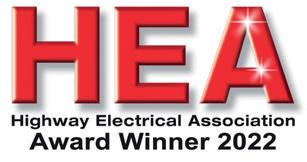

3 Each pillar comes with full technical document pack.

3 New MEGA range designed to meet client demand for larger pillars.
DISTRIBUTION CABINETS FOR EV CHARGE POINTS

Wessex Way, Wincanton Business Park, Wincanton, Somerset BA9 9RR Reg no 1855059 England CharlesEndirect.com +44(0)1963 828 400 info@charlesendirect.com
GOODBYE JESS!you‘ll be missed
Dear Jess,


‘Any CEO is only as good at the support they receive. In Jess I was extremely fortunate. At her interview over 20 years ago she was confident, keen and easy to talk to. That never changed. It was invaluable to me that I could rely on her to deliver to perfection and beyond. She will be a great loss to the ILP and a massive asset for someone!’
Richard Frost, former Chief Executive, ILP


‘As far back as I can think Jess’ welcoming smile and kind words of encouragement have been there as one of the outward faces of the ILP. Her presence at either events or work meetings has always made a difference towards an inclusive and friendly environment where everyone is encouraged to speak up and step up. She will be missed by all of us!’
Lora Kaleva, BDP
‘Jess has always been the ILP for me. She knew where, what, when and who for everything I needed and was always there ready to help out and kick-start initiatives. Personally, she became a treasured friend and I’ll miss our time together on ILP business and beyond. These are big boots to fill!’
Kimberley Bartlett, Introba and ILP VP – Education

‘Working alongside Jess at so many events over so many years has been a privilege and an honour. Forever friendly and generous, I will miss Jess but wish her the best in her next adventure. Jess is one of the best communicators I have met – and always seems to have that tool you’ve forgotten!’
Brendan Keeley, SLL
‘Jess has been a light for me and the International Nighttime Design Initiative. Our partnership and friendship have resulted in wonderful projects and great conversations.’


Leni Schwendinger, Leni Schwendinger Light Projects
‘Jess is without a doubt the most passionate of lighting enthusiasts; she is always there, on the end of the phone or at countless events to help anyone out, making introductions and generally being an all-round fantastic person. She has been a constant in mine and many others lighting careers, and we thank her from the bottom of our hearts for everything she has done for us and the industry over the years.’
Rebecca Hatch, WSP and ILP Senior Vice President
‘Whenever I came to Rugby Jess always greeted me warmly and with friendly enthusiasm. More recently, she rang me up just to say “hi, I wanted to check you were ok”. This is a measure of the kind of person she is. Hi Lights during Covid kept me sane and in touch with others. She will be missed greatly at Rugby, but I wish her every success in her future career. Don’t be a stranger!’
Nick Smith, Nick Smith Associates



‘Jess has been a very enthusiastic and passionate person when it comes to fulfilling our lighting aspirations and realising the Institution’s vision. She has always been very thoughtful and supportive; listening in confidence, encouraging, motivating whilst initiating and leading from the background with creativity, a personal touch, eagerness to learn and ever sparkling in confidence.’
Elizabeth Thomas
, Walsall Council and former ILP President
‘It has been an absolute pleasure to work with Jess over the years. Her professional attitude, understanding of the lighting industry and dedication to her job really has set her apart as a unique talent. Never underestimate a quiet person who does not seek acknowledgement, as one who is also a solid gold asset to any team. I look forward to seeing the next chapter in the story of Jess!”
Emma Cogswell, IALD UK
JUNE 2023 LIGHTING JOURNAL 56
After 22 years at the forefront of shaping – and often leading – lighting’s conversations, the ILP’s Knowledge Transfer and Communications Manager Jess Gallacher will at the end of this month be moving on to pastures new. As our testimonials show, she will be sorely missed!

‘Jess leaves a hole and will be very big boots to fill! She has been a friend, not just a go-to for ILP/lighting information. I wish her every success on her new venture. Any company is lucky to have her!’
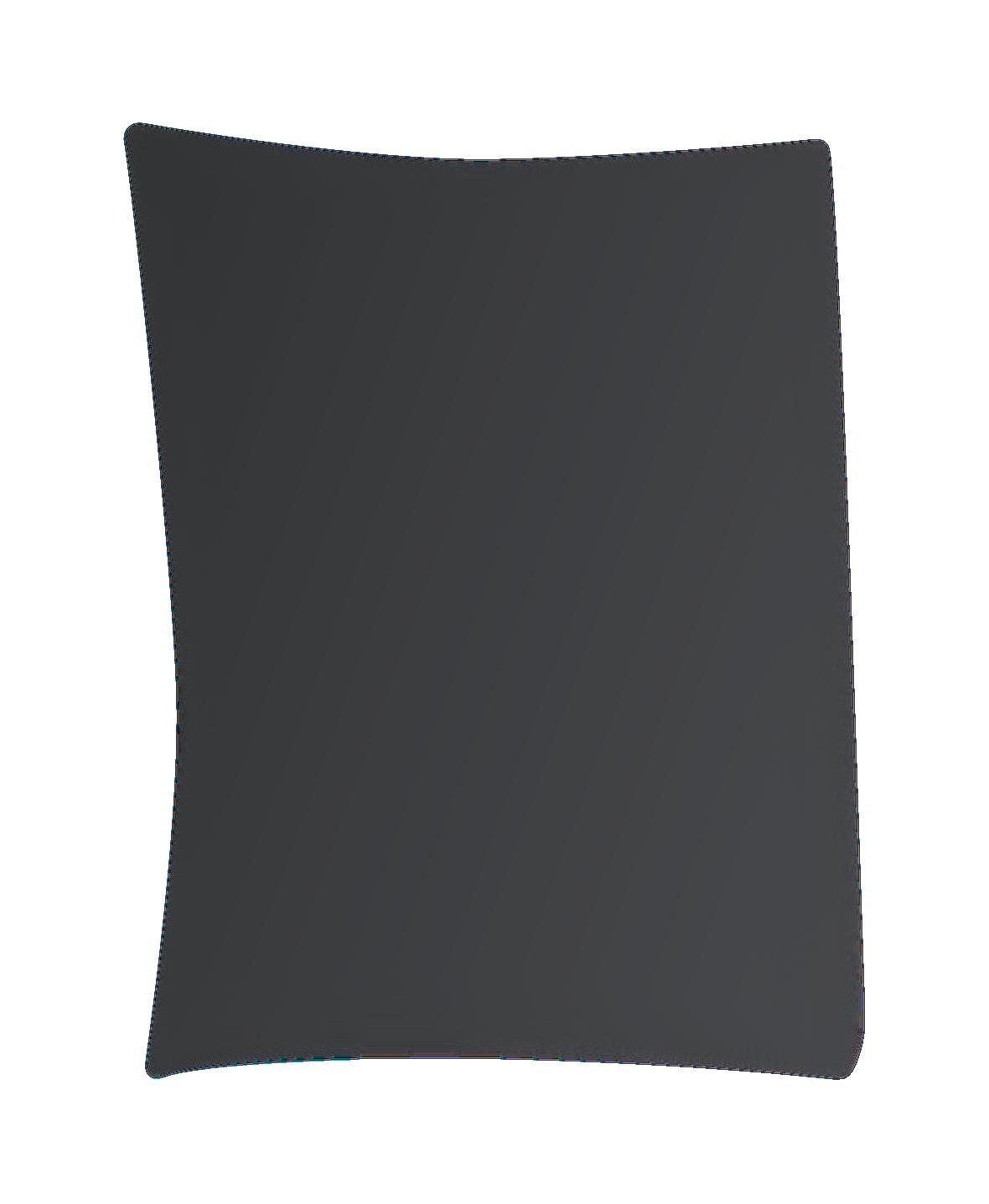 Fiona Horgan, City of Doncaster Council
Fiona Horgan, City of Doncaster Council
and ILP President
‘Jess, you’ve helped to make lighting a welcoming industry for so many people. You have been instrumental in helping us all to work together, recognising that we are all passionate about lighting, no matter what our affiliation within the industry. On top of that, you made it all fun! Thank you.’
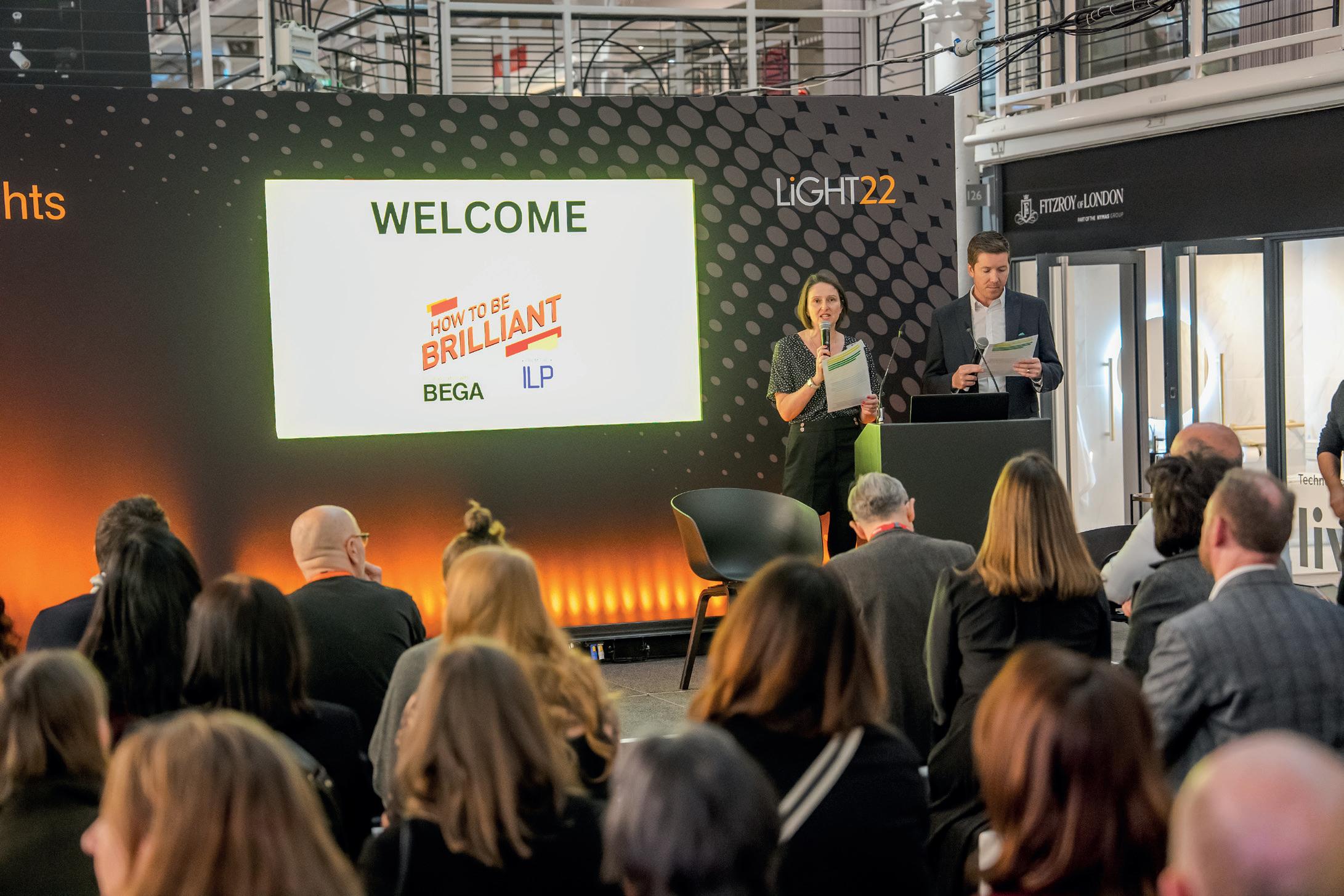 Ruth Kelly Waskett, Hoare Lea
Ruth Kelly Waskett, Hoare Lea
‘Jess is a “lighting hero”. She is the glue that holds the lighting community together, and although not a lighting designer herself, her love, passion and enthusiasm for lighting makes her one of us; she is loved, adored and respected by everyone in lighting. She has so much integrity and humility – one short talk with Jess and I joined the ILP!’
David Gilbey, d-lighting

‘Jess has been the ILP’s go-to person. Is there a problem, unsure of ILP procedures, need any contact details? Go to Jess. And every query is greeted with a smile and a polite “how are you?”. And what is special is that Jess actually cares about the answer. She is a cornerstone who will be sadly and acutely missed.’


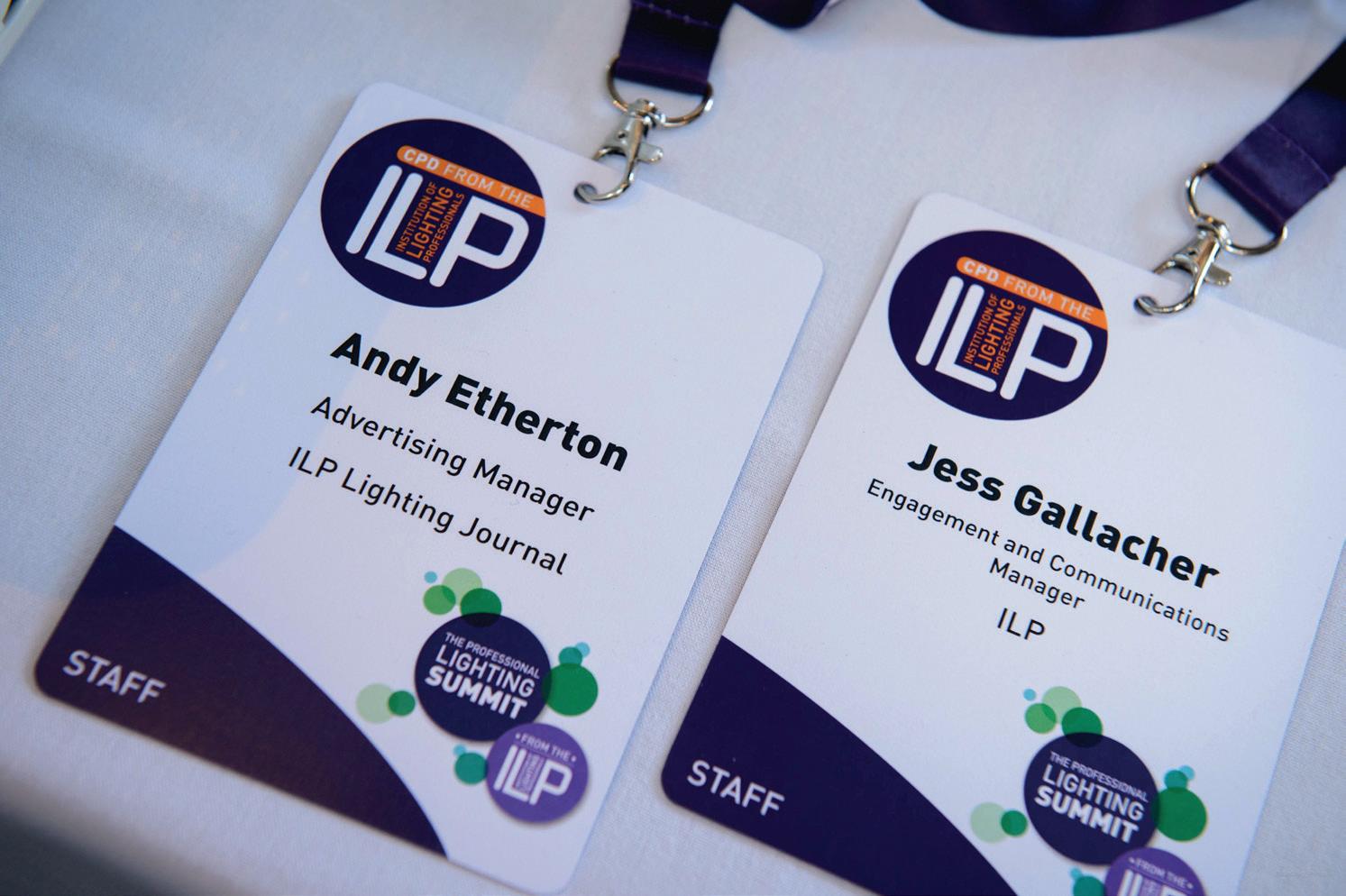 Kelly Smith, DFL
Kelly Smith, DFL
‘In the world of lighting, Jess shines particularly bright. Her passion and enthusiasm is infectious, and her ability to stand up for and articulate the need for equity in this industry and beyond is an inspiration.‘
Juliet Rennie, SLL
‘I recall when Jess first joined the ILE (as it was then) whilst I was prepping for President back in 2001/02. She threw herself into her role and really got involved as much as she could, and that has never waned. Her enthusiasm is what I will miss the most. With Jess, the glass is never just half full, but full to the brim!’
Nigel Parry, OrangeTek and former ILP President
‘I will always remember Jess as the friendly face of the ILP. Her unprecedented positive energy and social skills attracted many of us to join the Institution whilst contributing to the network of lighting designers tremendously. She is an irreplaceable talent whose efforts added so much value to our community.’
Kerem Asfuroglu, Dark Source

‘Jess has been so helpful throughout my time as a volunteer with the YLP and ILP. She has always been there to assist and offer advice, and always with such enthusiasm. Jess has been a core part of the ILP team for many years and helped drive its continued success.’
James Duffin, Enerveo and ILP Honorary Treasurer
‘Laurel and Hardy, the two Ronnies, Ant and Dec – there are many hilarious double acts that we will never be likened to, but I will miss the laughs we have at How to be Brilliant. Thank you for being so organised that I don’t need to be!’
Rob Hall, BEGA
‘You have made the world of lighting a better place, illuminating important issues and raising the game on ILP events. Alongside many others, I have valued your support on a professional and also personal level for 20 years and I know you will shine brightly wherever your path takes you’
Sharon Stammers, Light Collective
www.theilp.org.uk JUNE 2023 LIGHTING JOURNAL 57 Inside the ILP
ALWAYS A WAY TO IMPROVE LIGHTING TO BENEFIT THE USERS OF A SPACE’
With the position of Young Lighting Professionals chair set to hand over later this month, current YLP chair Toby Penter outlines how he came into the industry and what inspires him about lighting
By Toby Penter
TELL US ABOUT YOURSELF
I’m Toby Penter, senior lighting engineer at WSP and current chair (at the time of writing!) of the Young Lighting Professionals (YLP).
My main focus has been on environmentally sensitive lighting design and impact assessments, but I work on all sorts of projects as they come up.
HOW DID YOU GET INTO LIGHTING?
Like a lot of people, I sort of fell into it. I did a business and accounting degree, and was offered a business development role off the back of this at INDO Lighting.
I met some fantastic people there and started doing more and more lighting and product development work.
Eventually, I moved to working on lighting full time as a designer and then senior engineer at DFL-UK, before moving to WSP.
WHY LIGHTING?
I didn’t set out to end up in lighting – but took a real interest when I started in my first role.
Lighting is deceptively important to people and places, has a massive impact on our lives; it is constantly changing, developing and evolving.
In the beginning I had ‘plausible deniability’ to being a lighting professional – I was, after all, working in business development.
But after engaging with the industry for a couple of years, meeting people and learning the theory (and practice) of lighting, I decided to jump in fully.
WHAT DO YOU FIND MOST INTERESTING ABOUT YOUR ROLE AND WHY?
I’m a bit of an environmentalist at heart, and there is such fantastic scope to have a positive impact on the world through lighting.
JUNE 2023 LIGHTING JOURNAL 58
‘THERE’S
Whether pushing for a warmer colour temperature to protect nearby wildlife, putting shields in to reduce glare for a resident, or reducing lighting levels to save energy and reduce carbon emissions –there’s always a way to improve lighting to benefit the users of a space, people nearby, or the wider environment.




I love the amazement you see when explaining to people outside of lighting what can be changed and improved about a scheme. I think lighting appears very accessible but has a lot of detail hidden under the surface. I really enjoy bringing this detail out, explaining it, and securing positive changes as a result.
I also find it really interesting to find work I’ve done out in the wild. There’s a terrible picture of me, for example, (overleaf) staring at a streetlight I found on holiday, because it had a lamp I helped develop!

HAVE YOU BEEN INVOLVED IN ANY PROJECTS YOU ARE PARTICULARLY PROUD OF, AND WHY?
Ironically the project that I’ve been involved in since getting into the lighting industry that I’m most proud of has nothing to do with lights!
During the first lockdown, INDO switched its focus over to making powered air purifying respirators for NHS staff, delivering thousands of units to hospitals across the country.

This was a very personal project for me; as my mum, sister and aunt all ended up receiving this type of PPE to use in their roles in the NHS.

The projects I enjoy the most, and am always most proud of, are ones where they are geographically close to members of my family or friends. It’s always great to be able to talk to people you know about your work.
Young and new lighters
I’ve had projects in Hampshire, in Northamptonshire, near Swindon and in London that have been seen and acknowledged by people I know. I’ve also worked on projects for ports (see image overleaf). It’s always a fantastic feeling to see your work being noticed.
I was also really proud with the work I did developing new products and spectrums of lighting for horticulture in my role with INDO. This included attending events with Tom and Lawrence Baynham across Europe, where I was proud of how I presented myself.


HOW DOES LIGHT INSPIRE YOU?

When light inspires me, it’s inspiring me to improve the world around me. Light is such a versatile medium to adapt and control to improve spaces, and I’m inspired by the different things we can do with it.
WHAT BARRIERS OR CHALLENGES ARE THERE FOR YOUNG PEOPLE TO ENTER THE INDUSTRY?
As you can imagine, as chair of the YLP I’ve got quite a few thoughts on this one!
In the first instance, the biggest barrier for young people is knowing about the industry in the first place.
Even then, once into the industry, a lack of support from employers to attend events and expand their horizons can severely hold back young people from progressing.
I think a lot of the challenges faced by young people once they’re in the industry are the same challenges faced everywhere. Younger people’s expertise is often disregarded because of their limited experience, or it’s assumed they don’t have experience at all.
 Toby’s work has included developing new horticultural lighting products (top). His time at INDO took him to various conferences in Europe (above right) as well as being mentored by Scott Pengelly (in the background, bottom left). But he also still tries to make time for hobbies such as surfing
Toby’s work has included developing new horticultural lighting products (top). His time at INDO took him to various conferences in Europe (above right) as well as being mentored by Scott Pengelly (in the background, bottom left). But he also still tries to make time for hobbies such as surfing
JUNE 2023 LIGHTING JOURNAL 59
Toby ‘modelling’ the INDO air purifying respirator, developed for NHS staff during the Covid-19 pandemic
MEDIA IN MOTION ARCDOT™ anolislighting.com ARCPIX II™
Young and new lighters
A lot of the challenges faced by young people are also more significant for younger women, and people from ethnic minority backgrounds. These aren’t necessarily specific to the lighting industry, but to all of engineering.
DO YOU HAVE A MENTOR OR SOMEONE WHO HAS PARTICULARLY INSPIRED OR SUPPORTED YOU?
I’ve been positively influenced by lots of people throughout my life so far and my time in the lighting industry.
But I have been mentored really well across my career by my first boss, Rebecca Hatch, who will of course become ILP President at this month’s Professional Lighting Summit.
Also, Scott Pengelly gave me my very first lesson on Lighting Reality and has been around for a chat any time I needed him over the last five years.
I owe most of what I know about environmentally sensitive lighting to the immensely supportive Ryan Carroll – my current vice chair on the YLP and, from later this month, the incoming YLP chair.
WHAT WOULD YOU IDENTIFY AS KEY CHALLENGES FACING THE INDUSTRY FOR THE FUTURE?

I think the main challenge facing the lighting industry in the near future is a funding question.
As more and more lighting is upgraded to LED, the potential cost savings of further upgrades become less and less, making business cases for large LED rollouts harder to build.
Unless a step-change comes in in terms of how lighting as an asset is monetised, there is a risk of a bit of a ‘lighting bubble’.
Some of this will be offset by diversification, into export or areas such as horticulture, or through the sale of data harvesting tools, but will it be enough?
There are other challenges facing the industry that affect not only lighting but engineering as a discipline, or society as a whole. For example, how do we continue to reduce our impact on the environment?

How do we ensure our supply chains are ethical, and don’t support war or child labour? How do we push the lighting industry to be more inclusive and a more supportive environment for women and minority groups? How do we ensure lighting is not simply following societies trends but leading them?
HOW HAS THE ILP HELPED YOU ON YOUR LIGHTING ‘JOURNEY’?
The ILP has been a fantastic tool in pushing me out into the industry, getting me speaking opportunities, helping me with my membership upgrade and subsequent professional registration.
On top of this, it has offered me the roles that I have had in the YLP, which have given me a platform to support people in their professional growth.
WHAT’S YOUR AMBITION IN LIGHTING? WHERE WOULD YOU LIKE TO BE IN, SAY, 10 YEARS’ TIME?
Ten years from now I hope to have won the lottery and retired! But, failing that, I would love to be pushing myself to take on
new challenges, exploring different areas of lighting and involved in the continuous development of the ILP.
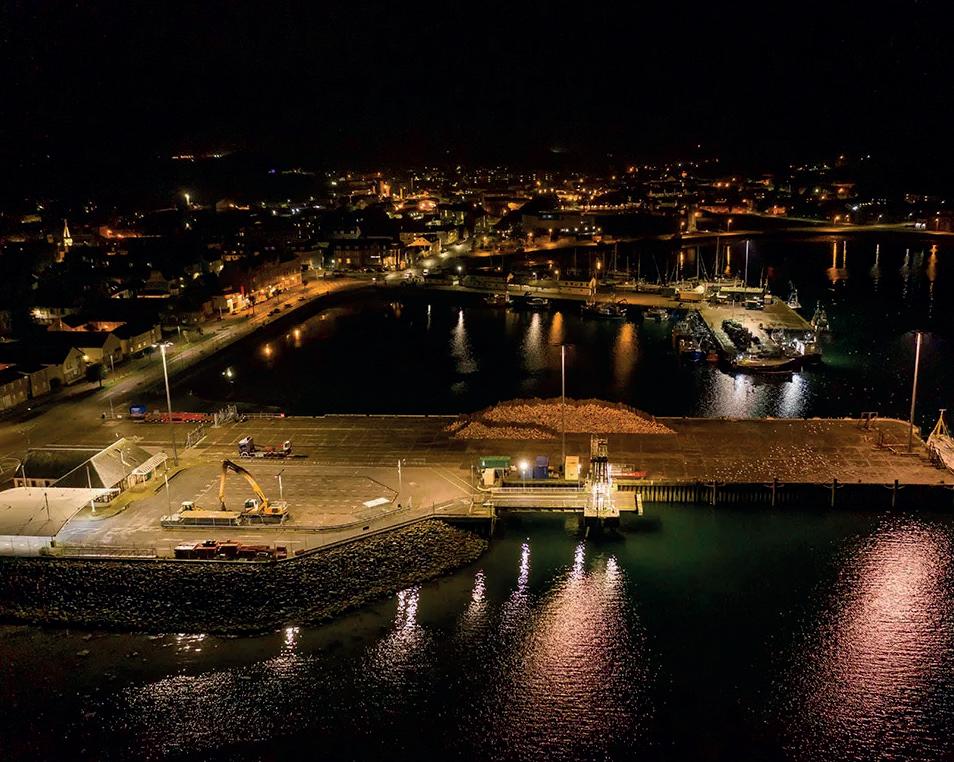
I hope (fingers crossed!) to have sorted out my CEng by then, and to be involved in writing documents being published by the ILP.
A lot of my ambitions these days fall outside of work – from improving my surfing, to travelling, to starting a family.
I’m always interested in ways in which I can integrate my interests into the work I do every day, and hope to explore some of these over the next 10 years.
WHAT WOULD BE YOUR MESSAGE TO OTHER YOUNG PEOPLE INTERESTED IN OR THINKING ABOUT A CAREER IN LIGHTING?
A career in lighting can be immensely rewarding – with loads of opportunity out there for people who want to take their own initiative.
My main piece of advice is to ask if you have any questions. There are so many resources out there to support people in the first few years of their lighting career, including of course the YLP!
Toby Penter BA (Hons) IEng MILP is senior lighting engineer at WSP and current chair of the Young Lighting Professionals (YLP)

GET IN TOUCH
Don’t forget, if you’re under 35 or new to the industry and would like to tell your story during 2023, simple email LightingJournaleditor Nic Paton on nic.cormorantmedia@outlook.com or the ILP’s Jess Gallacher on jess@ theilp.org.uk. We’ll then send you a questionnaire to fill in and return with a photograph. Simple!
JUNE 2023 LIGHTING JOURNAL www.theilp.org.uk 60

LIGHTING CONSULTANTS
This directory gives details of suitably qualified, individual members of the Institution of Lighting Professionals (ILP) who offer consultancy services

HERBIE BARNIEH
BEng CEng MILP PROJECT CENTRE
1 AMERICA SQUARE, LONDON, EC3N 2LS
T: 0330 135 8950, 077954 75570
HERBIE.BARNIEH@PROJECTCENTRE.CO.UK
WWW.MARSTONHOLDINGS.CO.UK/PROJECTCENTRE
Efficient, innovative, and bespoke lighting design services from an award winning consultancy.
Experienced in delivering exterior lighting projects from feasibility studies to post construction services. Whether it’s highway, street, or public realm lighting, let us assist you to realise your project goals.
STEVEN BIGGS
IEng MILP
MILESTONE INFRASTRUCTURE
PETERBOROUGH PE1 5XG
T: 07834 506705
STEVEN.BIGGS@MILESTONEINFRA.CO.UK
MILESTONEINFRA.CO.UK

Award winning lighting design specialists, delivering innovative design, installation and maintenance solutions in highways, public realm, commercial and architectural environments.
Our HERS registered team provide design strategies, impact assessment, technical & certifier support.


BONNIE BROOKS
BA(Hons) BEng (Hons) MSc
CEng MSLL MCIBSE MILP
THE LIGHTING BEE LTD

EXETER EX4 1NF
T: 07840 054601, E: INFO@THELIGHTINGBEE.CO.UK
WWW.THELIGHTINGBEE.CO.UK
Professional independent lighting design consultancy providing designs for all exterior applications, including street lighting. Specialists in assisting at the planning application stage with designs, strategies, lighting impact assessments, and expert witness, with a focus on mitigating ecological and environmental impacts.
SIMON BUSHELL
MBA DMS IEng MILP ENERVEO
PORTSMOUTH PO6 1UJ
M: +44 (0)7584 313990 T: +44 (0)121 387 9892
E: SIMON.BUSHELL@ENERVEO.COM
WWW.ENERVEO.COM
Professional consultancy from the UK’s and Irelands largest external lighting contractor. From highways and tunnels, to architectural and public spaces our electrical and lighting designers also provide impact assessments, lighting and carbon reduction strategies along with whole installation packages.
LORRAINE CALCOTT
IEng FILP IALD MSLL ILA BSS IT DOES LIGHTING LTD
THE CUBE, 13 STONE HILL, TWO MILE ASH, MILTON KEYNES, BUCKINGHAMSHIRE, MK8 8DN
T: 01908 560110 E: INFORMATION@ITDOES.CO.UK
WWW.ITDOES.CO.UK
Award winning lighting design practice specialising in interior, exterior, flood and architectural lighting. Emphasis on section 278/38, public realm, ecology receptor mitigation and supporting Councils with planning approvals, CDM2015 and SBD accredited. Specialists in circadian spectrally specific lighting design.
MARK CHANDLER
EngTech AMILP
MMA LIGHTING
CONSULTANCY LTD
READING RG10 9QN
T: 0118 3215636
E: MARK@MMA-CONSULTANCY.CO.UK
WWW.MMA-CONSULTANCY.CO.UK

Exterior lighting consultant’s who specialise in all aspects of street lighting design, section 38’s, section 278’s, project management and maintenance assistance. We also undertake lighting appraisals and environmental lighting studies
KEVIN RAMSAY
IEng MILP MIET SWECO
SWECO, EDINBURGH EH3 9QG
T: 07467685753 E: KEVIN.RAMSAY@SWECO.CO.UK
WWW.SWECO.CO.UK

Lighting and electrical design consultancy providing private and public sector innovative professional services. Specialising in Section 38, Section 278, RCC, highways, architectural, public spaces, car park, lighting impact assessments, Internet of Things, interior and emergency lighting, EV design. From planning to post-construction we provide innovative and environmental balanced solutions.
REBECCA HATCH
IEng MILP
WSP
LONDON WC2A 1AF
T: 07385 461143
E: REBECCA.HATCH@WSP.COM
WWW.WSP.COM
National team of specialist lighting and energy professionals offering the latest thinking and best client service across all aspects of lighting and energy, both public and private sector. Architectural, Highways, Environmental, Local Government, Electrical and Technical Expertise
STEPHEN HIGHAM
IEng MILP
SHD LIGHTING CONSULTANCY LTD
BOLTON BL2 6SE
M: 07834 490 192
E: STEVE@SHDLIGHTING.CO.UK
WWW.SHDLIGHTING.CO.UK

Outdoor lighting design consultancy specialising in street lighting and private lighting design services. We provide Section 38, Section 278, Car Park lighting designs, Commercial lighting and Environmental Impact Lighting Assessments and planning application consultancy advice throughout the UK.
ALLAN HOWARD
BEng(Hons) CEng FILP FSLL WSP
HERTFORD SG13 7NN
T: 07827 306483
E: ALLAN.HOWARD@WSP.COM
WWW.WSP.COM
Professional artificial and daylight lighting services covering design, technical support, contract and policy development including expert advice and analysis to develop and implement energy and carbon reduction strategies. Expert witness regarding obtrusive lighting, light nuisance and environmental impact investigations. registered personnel.
ALAN JAQUES
IEng FILP ATKINS

NOTTINGHAM, NG1 5FW
T: +44 (0)115 9574900 M: 07834 507070
E: ALAN.JAQUES@ATKINSGLOBAL.COM

WWW.ATKINSGLOBAL.COM
Professional consultancy providing technical advice, design and management services for exterior and interior applications including highway, architectural, area, tunnel and commercial lighting.
Advisors on energy saving strategies, asset management, visual impact assessments and planning.
PATRICK REDMOND
MILP MSLL IEng Tech IEI
REDMOND ANALYTICAL MANAGEMENT SERVICES LTD.

M: + 353 (0)86 2356356
E: PATRICK@REDMONDAMS.IE
WWW.REDMONDAMS.IE
Expert lighting and electrical infrastructure for all interior, exterior, and emergency lighting applications. On street EV charging infrastructure design. Authorising Officer and Live Working Manager for Local Authorities.
ANDREW LONGMAN
BEng (Hons) CEng MILP MIET
MHEA -Managing Director
DFL-UK

WINCHESTER SO23 7TA
T: +44 (0)1962 855080 M: +44 (0)7779 327413
E: ANDREW@DFL-UK.COM
WWW.DFL-UK.COM
Professional lighting design consultancy offering technical advice, design and management services for exterior/interior applications for highway, architectural, area, tunnel and commercial lighting. Advisors on lighting and energy saving strategies, asset management, visual impact assessments and planning.

ANTHONY SMITH
IEng FILP
STAINTON LIGHTING DESIGN SERVICES LTD
STOCKTON ON TEES TS23 1PX
T: 01642 565533, E: ENQUIRIES@STAINTONLDS.CO.UK
WWW.STAINTONLDS.CO.UK

Specialist in: motorway, highway schemes, illumination of buildings, major structures, public artworks, amenity area lighting, public spaces, car parks, sports lighting, asset management, reports, plans, assistance, maintenance management, electrical design, Lighting Impact Assessments and Dark Skies Compliant Lighting.
NICK SMITH
IEng FILP MIES
NICK SMITH ASSOCIATES LIMITED
CHESTERFIELD, S40 3JR
T: 01246 229444
E: MAIL@NICKSMITHASSOCIATES.COM
WWW.NICKSMITHASSOCIATES.CO.UK
Specialist exterior lighting consultant.
Private and adopted lighting and electrical design for highways, car parks, area and sports lighting. Lighting Impact assessments, expert witness and CPD accredited Lighting design AutoCAD and Lighting Reality training courses.
ALAN TULLA
IEng FILP FSLL
ALAN TULLA LIGHTING

WINCHESTER, SO22 4DS
T: 01962 855720
M:0771 364 8786
E: ALAN@ALANTULLALIGHTING.COM
WWW.ALANTULLALIGHTING.COM
Visual Impact Assessments for planning applications. Expert in minimising environmental impact. 3D building modelling of light spill. Exterior and Interior architectural lighting design. Site surveys and lighting measurements. Specialises in problem solving and out-of-the-ordinary projects..

MICHAEL WALKER
IEng MILP CMS
MCCANN LTD
NOTTINGHAM NG9 6DQ
M: 07939 896887
E: M.WALKER@JMCCANN.CO.UK
WWW.MCCANN-LTD.CO.UK
Design for all types of exterior lighting including street lighting, car parks, floodlighting, decorative lighting, and private lighting. Independent advice regarding light trespass, carbon reduction and invest to save strategies. Asset management, data capture, inspection and testing services available.
PETER WILLIAMS
EngTech AMILP
WILLIAMS LIGHTING CONSULTANTS LTD.
OFFICE 6, STONEHOUSE BUSINESS CENTRE, 1A MIDDLE ROW, CHIPPING NORTON, OX7 5NH
T: 01608 642530 E: PETER.WILLIAMS@WLCLIGHTING.CO.UK
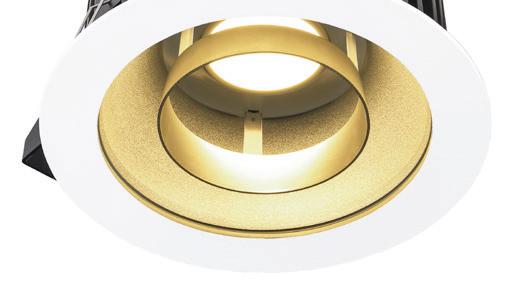
WWW.WLCLIGHTING.CO.UK
Specialists in the preparation of quality and effective street lighting design solutions for Section 38, Section 278 and other highway projects. We also prepare lighting designs for other exterior applications. Our focus is on delivering solutions that provide best value.

ILLUMINATING INTERIORS AMBIANE™ AP anolislighting.com WARMING COLOURS & ADJUSTABLE WHITES
Neither Lighting Journal nor the ILP is responsible for any services supplied or agreements entered into as a result of this listing
Discover NAVAR Series
Blending circular economy values with maximised performance through bespoke optical packages, the NAVAR Series o ers 0% ULOR and up to 48m spacings.

With more than 280 unique configurations and full smart controls capabilities, this collection allows for complete project versatility.
Colour temperature variants, catenary, post top, side entry and bespoke bracketry opportunities, all with a marine grade finish and e icient output places NAVAR ahead of the competition.

01623 415900 www.kingfisherlighting.com plc Part of the group of companies STREET | AMENITY | ARCHITECTURAL | SPORT | HIGH MAST | RAIL | CONTROLS
Celebrating a Century of British Manufacturing
Celebrating a Century of British Manufacturing

CU Phosco have had 100 award-winning years of illuminating roads, motorways, airports, ports, shopping centres, housing estates and sports stadiums - throughout the world.
A century ago, Charles Albert Marques M.B.E, founded Concrete Utilities.

As we celebrate the past and reflect on how far we’ve come, we’d like to take a moment to thank all of our wonderful customers, suppliers, partners and industry friends who have supported us over this incredible journey.
Here’s to the next 100!
+44 1920 860600 cuphosco.com enquiries@cuphosco.com






























 By Nic Paton
By Nic Paton












 By Nic Paton
By Nic Paton























































 By Michael Grubb
By Michael Grubb









































 The Nulty lighting scheme at the FitnGlam fitness studio in Dubai, here showing the ‘light corridor’
The Nulty lighting scheme at the FitnGlam fitness studio in Dubai, here showing the ‘light corridor’



























 By Nic Paton
By Nic Paton






















 By Steve Tonkin
By Steve Tonkin

























 [1] ‘The impact of Amendment 2 of the 18th edition (BS 7671:2018+A2:2022)’,
[1] ‘The impact of Amendment 2 of the 18th edition (BS 7671:2018+A2:2022)’,


































 Fiona Horgan, City of Doncaster Council
Fiona Horgan, City of Doncaster Council
 Ruth Kelly Waskett, Hoare Lea
Ruth Kelly Waskett, Hoare Lea
 Kelly Smith, DFL
Kelly Smith, DFL










 Toby’s work has included developing new horticultural lighting products (top). His time at INDO took him to various conferences in Europe (above right) as well as being mentored by Scott Pengelly (in the background, bottom left). But he also still tries to make time for hobbies such as surfing
Toby’s work has included developing new horticultural lighting products (top). His time at INDO took him to various conferences in Europe (above right) as well as being mentored by Scott Pengelly (in the background, bottom left). But he also still tries to make time for hobbies such as surfing























